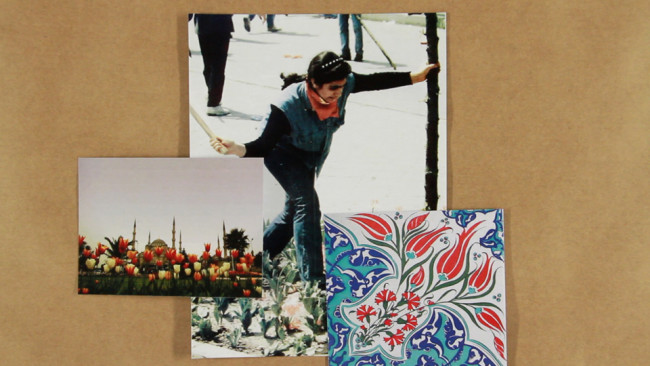
Aykan Safoǧlu
Aykan Safoğlu: Off-White Tulips (Kırık Beyaz Laleler), 2013, HD, Colour, 24´, Turkish; English s.t.
Aykan Safoǧlu
Off-White Tulips, 2013
Off-White Tulips is a tribute to the US-American writer James Baldwin. In this dense video essay, the artist links Baldwin’s self-imposed exile in Turkey with his own biographical details and an exploration of his native country. With the help of old photographs, we follow the path through Istanbul equally of James Baldwin as much as of Aykan Safoǧlu and his family. The emphasis on both personal stories quickly begins to blur fact and fiction. Safoǧlu calls this form biomythography – a type of invented life story coined by the American writer and activist Audre Lord, who described herself as a ‘black lesbian feminist mother warrior poet’. Off-White Tulips looks at history from marginal perspectives in order to explore alternative interpretations of cultural artefacts and differences, queer politics and identity. It is concerned with black survival strategies in a white mainstream. The film was awarded the Oberhausen Grand Prize at the Short Film Festival in Oberhausen in 2013.
Aykan Safoğlu
Aykan Safoğlu is an artist and short film maker Ausklappen...
Aykan Safoğlu is an artist and short film maker based in Berlin. After graduating from Istanbul Bilgi University, where he studied film, he completed his master′s degree in "Art in Context" at the University of the Arts Berlin in 2010. He also completed his MFA in Photography at Bard College in New York in 2013. Since 2005, Safoğlu has made several short films, published articles and reviews in various magazines. He has participated in many group exhibitions and curated them. In 2013, he received the Grand Prize of the City of Oberhausen in the 59th international Short Film Festival Oberhausen for his short film "Kırık Beyaz Laleler / Off-White Tulips." Safoğlu was awarded a 2014 residency at the Rijksakademie van beeldende kunsten in Amsterdam. He is a member of the curatorial collective “ğ” (soft g).
Aykan Safoğlu: Off-White Tulips (Kırık Beyaz Laleler), 2013, HD, Farbe, 24´, Türkisch; Englisch s.t.
Aykan Safoǧlu
Off-White Tulips, 2013
Off-White Tulips ist ein Homage an den amerikanischen Autor James Baldwin. In einem dichten Videoessay verbindet der Künstler Baldwinds selbstauferlegtes Exil in der Türkei mit Details aus seiner eigenen Biografie und einem Blick auf sein Heimatland. Mithilfe alter Fotografien folgen wir James Baldwin und Aykan Safoǧlu und dessen Familie gleichermaßen durch Istanbul. Der Fokus auf die persönlichen Geschichten von beiden lässt Fakt und Fiktion schnell verschwimmen. Safoǧlu nennt diese Form Biomythografie – eine Form der fiktiven Lebensgeschichte, begründet von der amerikanischen Autorin Audre Lord, die sich selbst als “black lesbian feminist mother warrior poet” bezeichnet. Off-White Tulips blickt aus marginalisierten Perspektiven auf die Geschichte um daraus alternative Interpretationen kultureller Artefakte und Differenzen sowie von Queer Politik und Identität zu ziehen. Das Werk befasst sich mit schwarzen Überlebensstrategien innerhalb eines weißen Mainstreams. Der Film wurde mit dem Oberhausen Grand Prix beim Kurzfilm-Festival 2013 in Oberhausen ausgezeichnet.
Aykan Safoğlu
Aykan Safoğlu ist Künstler und Kurzfilmer Ausklappen...
Aykan Safoğlu ist Künstler und Kurzfilmer. Er studierte Film an der Istanbul Bilgi Universität und schloss 2010 den Masterstudiengang Kunst im Kontext an der Universität der Künste ab. Es folgte ein MFA Abschluss in Fotografie am Bard College in New York im Jahr 2013. Seit 2005, hat Safoğlu mehrere Kurzfilme realisiert, und in verschiedenen Magazinen Artikel und Essays veröffentlicht. Er hat an zahlreichen Gruppenausstellungen teilgenommen und ebenso kuratiert. 2013 erhielt er den Großen Preis der 59. Internationalen Kurzfilmtage Oberhausen für seinen Kurzfilm "Kırık Beyaz Laleler / Off-White Tulips". Safoğlu wurde 2014 mit einem Stipendium der Rijksakademie in Amsterdam ausgezeichnet. He ist Mitglied des Kuratornkollektives “ğ” (soft g).
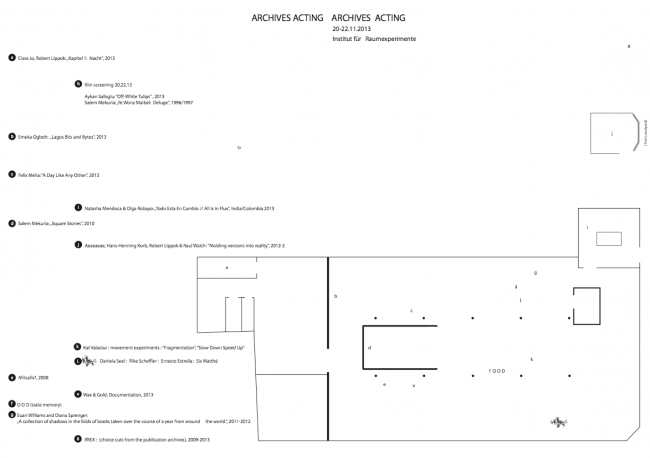
Archives Acting
Archives Acting is an exhibition curated on occasion of the Archives Works Marathon and hosted at the Institut für Raumexperimente and the Grey Sheep project housed at Studio Olafur Eliasson.
Archives Acting is choreographed by Eric Ellingsen and Christina Werner with contributions by Aeaeaeae, Hans-Henning Korb, Robert Lippok, and Raul Walch; Clara Jo and Robert Lippok; Salem Mekuria; Felix Melia; Natasha Mendonca and Olga Robayo; Netsa Art Village, Mihret Kebede, and Robel Temesgen; Emeka Ogboh; Elvira Dyangani Ose and Pere Ortín; Aykan Safoǧlu; Daniela Seel, Rike Scheffler, Ernesto Estrella, and Sis Matthé; Diana Sprenger and Euan Williams; and Kat Válastur.
Aeaeaeae, Hans-Henning Korb, Robert Lippok, and Raul Walch
Molding Versions into Reality, 2012-2013
Everything is knot together here. Everything hanging here comes from Ethiopia, even the things that come from China, and this is reality. This is the sound of reality snared and knotted together from stories and streets and markets and roundabouts in Addis Ababa. This is archive’s opposite, a moment of chaotic similarities. A sound installation as part of the Grey Sheep project.
Tainá Guedes, Asako Iwama, Lauren Maurer, and Lynn Peemoeller
f : O O D, 2013
Served in the context of the marathon days, these taste memory experiments, recipes, menus, and thoughts are provided by Tainá Guedes, Asako Iwama, Lauren Maurer, and Lynn Peemoeller. Menu designed by Thomas Meyer.
Clara Jo and Robert Lippok
24h Dahlem, Kapitel 1: Nacht, 2013
24h Dahlem centres on the controversial re-location of the ethnographic collections of the Dahlem Museums to the future site of the Humboldt Forum in Berlin’s city centre. Combining material from two archives within the Ethnological Museum and the Museum for Asian Art, the resulting large-scale video installations are presented in three chapters in the Dahlem Museum. 24h Dahlem was produced in the context of the Humboldt Lab Dahlem, a project of the German Federal Cultural Foundation and the Prussian Cultural Heritage Foundation.
Director: Clara Jo; sound design & audio archive composition: Robert Lippok; director of photography: Michael Laakmann
Felix Melia
A Day Like Any Other, 2013
A Day Like Any Other is a video work comprised of appropriated video and audio from the Aquis Bryant film Hood 2 Hood: The Blockumentary and Samuel Beckett’s Endgame. The video draws a comparison between the repetitive, cyclical nature of events in Beckett’s play and the similarly recurrent explanations and stories of ‘real’ life in Hood 2 Hood, stories that allude to the sedentary metaphysics and social immobility imposed upon its protagonists. The words ‘all day everyday’ literally encircle the imagery of the work. A commonly employed assertion within the appropriated footage, these words describe a refusal to give in, while highlighting the limited dynamic of the environments the protagonists inhabit.
Salem Mekuria
Ye Wonz Maibel: Deluge, 1996/1997
Ye Wonz Maibel: Deluge is a personal visual meditation on history, conflict, and the roads to reconciliation. It is a tale of love and betrayal, of idealism and the lure of power. It is a memorial to a brother who disappeared and a best friend, executed. It is a story of the Ethiopian students, their ‘revolution’, and its aftermath – a brutal military dictatorship. Ye Wonz Maibel: Deluge contemplates the role of the individual in perpetuating national tragedies – be that famine, war, or political terror – by re-visiting family tragedies in Ethiopia. Focusing on and searching through her own history, Mekuria sought personal experiences that illuminated universal truths. The film offers tools for reflection in order to look forward to a future in which responsibility and choice inform our conduct.
Salem Mekuria
Square Stories, 2010
Square Stories is a triptych video installation. Maskal Square (Revolution Square, or just ‘the Square’), located in the centre of Addis Ababa, Ethiopia, is a massive concrete expanse framed by permanent bleachers. It is the lowest point in the city: everything cascades into the Square. Everything big that happens in the city takes place there. The Square is also a site of commemoration, anchored by two museums that offer stable, corporealised narratives of the city and the nation. Square Stories offers a way of bearing witness to these multiple, fragmentary histories. It presents Maskal Square both as place and metaphor culled from a childhood in Addis Ababa and the gaze of an American art professor. The triptych format, which gestures to Ethiopia’s religious and cultural history, amplifies the contradictions within history, memory, and narration and interrogates the failure of any one story to stand in for the manifold subjectivities that comprise Ethiopian identity and history.
Writer/producer/videographer/director: Salem Mekuria; editor: Sarah B. Peck
Natasha Mendoca & Olga Robayo
Todo Esta En Cambio // All is in Flux, 2013
Todo Esta En Cambio navigates through sounds that seamlessly crisscross India and Colombia. This sonic journey takes us through the agrarian crisis and the consequences of the free trade treaty signed between India, Colombia, and the United States. The sound makes links between how food is produced in an industrialised world without consideration for the farmers, and how political leaders and corporations are leading the world to further environmental and socio-political disasters in the name of profit.
Netsa Art Village
Wax&Gold, 2013
Wax&Gold is a documentation of the Wax&Gold workshop for freedom of artistic expression that took place at Netsa Art Village and was accompanied by a touring exhibition in Addis Ababa, July 2012. Wax&Gold, a project developed and designed by Netsa Art Village and funded by the Prince Claus Fund, embraces the historical Ethiopian tradition of ‘Wax and Gold’, an approach involving indirect methods of communication, a strong form of expression in Ethiopian literature called ‘Qinie’, which obscures and protects the main message, the ‘Gold’, by covering it with ‘Wax’.
Presented by Mihret Kebede & Robel Temesgen.
Emeka Ogboh
Lagos Bits and Bytes, 2013
An electro-acoustic exploration of a bustling amphitheatre of sounds, a sprawling metropolis, and an aspiring megalopolis – Lagos, Nigeria. This is an excerpt from a Lagos soundscapes project, an acoustic enquiry into the mega-city focused on capturing sounds that define the unique character of Lagos and reflect the city’s diversity.
Elvira Dyangani Ose & Pere Ortín
Africalls?, 2008
Africalls? is a documentary film that shows the work of five artists and two production centres of contemporary art in seven African cities. It shows the interests that motivate them and the urban context from which they create their artworks. Africalls? approaches these artists’ work from an unusual perspective, exploring their personalities and creative processes as well as the art objects they make in Dakar, Douala, Cape Town, Rabat, Luanda, Nairobi, and Maputo. Africalls? is an audiovisual journey through the contemporary art of an urban Africa: both cosmopolitan and little-known, local and global.
Curator: Elvira Dyangani Ose; director: Pere Ortín; producer: Vic Pereiró
Aykan Safoǧlu
Off-White Tulips, 2013
Off-White Tulips is a tribute to the US-American writer James Baldwin. In this dense video essay, the artist links Baldwin’s self-imposed exile in Turkey with his own biographical details and an exploration of his native country. With the help of old photographs, we follow the path through Istanbul equally of James Baldwin as much as of Aykan Safoǧlu and his family. The emphasis on both personal stories quickly begins to blur fact and fiction. Safoǧlu calls this form biomythography – a type of invented life story coined by the American writer and activist Audre Lord, who described herself as a ‘black lesbian feminist mother warrior poet’. Off-White Tulips looks at history from marginal perspectives in order to explore alternative interpretations of cultural artefacts and differences, queer politics and identity. It is concerned with black survival strategies in a white mainstream. The film was awarded the Oberhausen Grand Prize at the Short Film Festival in Oberhausen in 2013.
Daniela Seel, Rike Scheffler, Ernesto Estrella, and Sis Matthé
L-A-N-G-U-A-G-I-N-G, 2013
L-A-N-G-U-A-G-I-N-G is a series of writing experiments and spontaneous language swerves informed by a space of listening. For two days, four poets tweeted echoes of what they heard from a listening space in the context of the Archives Works Marathon. The tweets can be found under the Twitter handle @Raumexperimente.
Diana Sprenger and Euan Williams
A Collection of Shadows in the Folds of Books Taken over the Course of a Year from Around the World, 2011-2012
In the folds of books. Reproduced shadows. Heightening the ephemeral quality of a book as a physical entity. A movable and borderless publication. Free of obvious geographical and temporal marks, yet created out of the temporal and geographical relationship between a source of light, an object, and the moment in which a photo is taken. A merging of real shadows with represented ones. Past mixes with present, as northern hemisphere mixes with southern hemisphere.
Kat Válastur
Fragmentation, Slow Down, Speed Up (Sketches), 2013
Movement experiments developed and demonstrated by the artist to collectively test moving in and against time
Institut für Raumexperimente
A presentation of selected visual material from the archives of the Institut für Raumexperimente, 2009-2013.
Archives Acting ist eine Ausstellung, die anlässlich des Archives Works Marathons kuratiert wurde und im Institut für Raumexperiemente sowie dem Grey Sheep Projekt im Studio Olafur Eliasson gezeigt wird.
Archives Acting wurde von Eric Ellingsen und Christina Werner choreografiert und zeigt Beiträge von Aeaeaeae, Hans-Henning Korb, Robert Lippok, und Raul Walch; Clara Jo und Robert Lippok; Salem Mekuria; Felix Melia; Natasha Mendonca und Olga Robayo; Netsa Art Village, Mihret Kebede und Robel Temesgen; Emeka Ogboh; Elvira Dyangani Ose und Pere Ortín; Aykan Safoǧlu; Daniela Seel, Rike Scheffler, Ernesto Estrella und Sis Matthé; Diana Sprenger und Euan Williams sowie Kat Válastur.
Aeaeaeae, Hans-Henning Korb, Robert Lippok und Raul Walch
Molding versions into reality, 2012-2013
Alles hier ist miteinander verknotet. Alles was hier hängt kommt aus Äthiopien, sogar die Dinge die aus China kommen und das ist die Realität. Das ist der Klang der Realität, eingefangen und zusammengeknotet aus Geschichten und Straßen und Märkten und Kreisverkehren in Addis Abeba. Das ist das Gegenteil des Archivs, ein Moment chaotischer Ähnlichkeiten. Eine Klanginstallation als Teil des Grey Sheep Projektes.
Tainá Guedes, Asako Iwama, Lauren Maurer und Lynn Peemoeller
f : O O D, 2013
Diese leckeren Erinnerungsexperimente, Rezepte, Menüs und Ideen werden im Rahmen der Marathon-Tage von Tainá Guedes, Asako Iwama, Lauren Maurer und Lynn Peemoeller aufgetischt. Entwurf des Menüs von Thomas Meyer.
Clara Jo und Robert Lippok
24h Dahlem, Kapitel 1: Nacht, 2013
24h Dahlem positioniert sich rund um die kontroverse Umsiedelung der ethnografischen Sammlung aus den Museen Dahlem an ihren zukünftigen Ort, das Humboldt Forum im Stadtzentrum Berlins. Mit einer Mischung aus Materialien zweier Archive des Ethnologischen Museums und des Museums für Asiatische Kunst werden die daraus entstandenen großformatigen Videoinstallationen in drei Kapiteln in den Museen Dahlem gezeigt. 24h Dahlem wurde im Rahmen des Humboldt Lab Dahlem produziert, einem Projekt der Kulturstiftung des Bundes und der Stiftung Preußischer Kulturbesitz.
Regie: Clara Jo; Sounddesign & und Komposition der Audioarchive: Robert Lippok; Kamera: Michael Laakmann
Felix Melia
A Day Like Any Other, 2013
A Day Like Any Other verwendet Video- und Audiomaterial des Films Hood 2 Hood: The Blockumentary von Aquis Bryant und Samuel Becketts Endspiel. Das Video zieht einen Vergleich zwischen der sich wiederholenden, zyklischen Struktur der Ereignisse in Becketts Stück und den genauso repetitiven Erklärungen und Geschichten des „echten“ Lebens in Hood 2 Hood. Dies sind Geschichten, welche auf die immobile Metaphysik und soziale Unbeweglichkeit hinweisen, welche den Protagonisten auferlegt sind. Die Formulierung „den ganzen Tag, jeden Tag“ umschreibt wortwörtlich die Bildwelten dieses Werks. Als wiederholte Beteuerung innerhalb der appropriierten Filmelemente steht diese Formulierung für Weigerung nachzugeben während sie gleichzeitig die eingeschränkte Dynamik der Umgebung, in der die Protagonisten sich befinden, herausstellt.
Salem Mekuria
Ye Wonz Maibel: Deluge, 1996/1997
Ye Wonz Maibel: Deluge ist eine persönliche, visuelle Meditation über Geschichte, Konflikten und Wegen, die zur Versöhnung führen. Es ist eine Geschichte über Liebe und Betrug, Idealismus und die Verführung der Macht. Es ist ein Denkmal an einen Bruder der verschwand und einen besten Freund der exekutiert wird. Erzählt wird die Geschichte der äthiopischen Studenten, ihrer „Revolution“ und dem was darauf folgt – eine brutale Militärdiktatur. Ye Wonz Maibel: Deluge denkt über die Rolle des Individuums in bestehenden nationalen Tragödien nach – das können Hungersnöte, Kriege oder politischer Terror sein – indem Familientragödien in Äthiopien neu betrachtet werden. Mit suchendem Fokus auf ihre eigene Geschichte greift Mekuria, persönliche Erfahrungen auf, die universelle Wahrheiten aufscheinen lassen.
Salem Mekuria
Square Stories, 2010
Square Stories ist eine Videoinstallation im Tryptichon-Format. Der Maskal Square Platz (Revolution Square oder einfach auch “the square”) liegt im Zentrum von Addis Abeba, Äthiopien, und ist eine große Betonfreifläche, die von fest installierten Tribünen begrenzt ist. Der Platz ist der niedrigstgelegene Punkt der Stadt: Alles läuft auf den Square zu. Alle großen Ereignisse in der Stadt finden hier statt. Der Platz ist auch ein Ort für Erinnerung. Zwei Museen, die hier Orientierungspunkte bieten stehen für konstante, verkörperte Narrationen der Stadt sowie der Nation. Square Stories bietet einen Zugang, um Zeugnis für diese vielseitigen, fragmentierten Geschichten abzulegen. Der Maskal Square wird sowohl als Platz als auch als Metapher präsentiert. Das Triptychon-Format, das der religiösen und kulturellen Geschichte Äthiopiens entlehnt ist, unterstreicht die Widersprüchlichkeit, die der Geschichte, der Erinnerung und der Narration zugrunde liegen. Gleichzeitig unterstreicht es, dass seither keine einzelne Geschichte repräsentativ für die vielseitigen Subjektivitäten, aus denen die äthiopische Identität und Geschichte bestehen, einstehen konnte.
Autor/Produzent/Kamera/Regie: Salem Mekuria; Schnitt: Sarah B. Peck
Natasha Mendoca & Olga Robayo
Todo Esta En Cambio // All is in Flux, 2013
Todo Esta En Cambio navigiert durch Klänge, die Indien und Columbien nahtlos im Zickzack durchqueren. Diese Klangreise nimmt uns mit durch eine Landwirtschaftskrise und deren Auswirkungen auf das freie Handelsabkommen zwischen Indien, Kolumbien und den Vereinigten Staaten. Der Klang stellt Verbindungen zwischen der Nahrungsmittelproduktion in einer industrialisierten Welt her, wo Bauern nicht mit in Betracht gezogen werden, und der Art, auf die Politiker und Firmen im Namen des Profits die Welt in weitere umwelttechnische und sozio-politische Desaster führen.
Netsa Art Village
Wax&Gold, 2013
Wax&Gold ist eine Dokumentation des Wax&Gold Workshops für die Freiheit künstlerischen Ausdrucks, der im Netsa Art Village stattfand und von einer Wanderausstellung in Addis Abeba im Juli 2012 begleitet wurde. Wax&Gold, ein Projekt das vom Netsa Art Village entwickelt und gestaltet wurde, sowie vom Prince Claus Fonds mitgetragen wird, übernimmt die historische äthiopische Tradition des “Wax & Gold”. Dieser Ansatz umfasst indirekte Kommunikationsformen, eine in der äthiopischen Literatur starken Ausdrucksform namens “Qinie”, welche die zu transportierende Aussage gleichermaßen verschleiert als auch schützt. Das “Gold” wird hier mit “Wachs” überzogen.
Präsentiert von Mihret Kebede & Robel Temesgen.
Emeka Ogboh
Lagos Bits and Bytes, 2013
Ein elektroakustischer Erkundungsgang durch ein klangerfülltes Theater, eine lebendige Metropole und eine aufstrebende Megalopole – Lagos in Nigeria. Dies ist ein Ausschnitt aus einem Projekt, das mit den Klanglandschaften Lagos arbeitet und eine akustische Befragung der Megastadt ist. Der Fokus liegt dabei darauf, Klänge einzufangen, die den einzigartigen Charakter der Stadt Lagos bestimmen und die Diversität der Stadt widerspiegeln.
Elvira Dyangani Ose & Pere Ortín
Africalls?, 2008
Africalls? ist ein Dokumentationsfilm, der die Arbeit von fünf Künstlern und zwei Produktionszentren für zeitgenössische Kunst in sieben afrikanischen Städten zeigt. Africalls? thematisiert die Arbeiten dieser Künstler aus einer ungewöhnlichen Perspektive, zeigt ihre Persönlichkeiten und Kreativprozesse sowie Kunstwerke, die sie in Dakar, Douala, Kapstadt, Rabat, Luanda, Nairobi und Maputo schaffen. Africalls? ist eine audiovisuelle Reise durch die zeitgenössische Kunst eines urbanen Afrikas: Kosmopolitisch und wenig bekannt, lokal und global.
Kurator: Elvira Dyangani Ose; Regisseur: Pere Ortín; Produktion: Vic Pereiró
Aykan Safoǧlu
Off-White Tulips, 2013
Off-White Tulips ist ein Homage an den amerikanischen Autor James Baldwin. In einem dichten Videoessay verbindet der Künstler Baldwinds selbstauferlegtes Exil in der Türkei mit Details aus seiner eigenen Biografie und einem Blick auf sein Heimatland. Mithilfe alter Fotografien folgen wir James Baldwin und Aykan Safoǧlu und dessen Familie gleichermaßen durch Istanbul. Der Fokus auf die persönlichen Geschichten von beiden lässt Fakt und Fiktion schnell verschwimmen. Safoǧlu nennt diese Form Biomythografie – eine Form der fiktiven Lebensgeschichte, begründet von der amerikanischen Autorin Audre Lord, die sich selbst als “black lesbian feminist mother warrior poet” bezeichnet. Off-White Tulips blickt aus marginalisierten Perspektiven auf die Geschichte um daraus alternative Interpretationen kultureller Artefakte und Differenzen sowie von Queer Politik und Identität zu ziehen. Das Werk befasst sich mit schwarzen Überlebensstrategien innerhalb eines weißen Mainstreams. Der Film wurde mit dem Oberhausen Grand Prix beim Kurzfilm-Festival 2013 in Oberhausen ausgezeichnet.
Daniela Seel, Rike Scheffler, Ernesto Estrella, und Sis Matthé
L-A-N-G-U-A-G-I-N-G, 2013
L-A-N-G-U-A-G-I-N-G ist eine Serie aus Schreibexperimenten und spontanen Sprachnotizen, beeinflusst von einem “Zuhörort”. Zwei Tage lang tweeteten vier Dichter Echos dessen was sie an diesem Ort im Rahmen des Archives Works Marathon hörten. Ihre Tweets finden sich bei Twitter unter @Raumexperimente.
Diana Sprenger und Euan Williams
A Collection of Shadows in the Folds of Books Taken over the Course of a Year from Around the World, 2011-2012
Zwischen den Falten von Buchseiten. Reproduzierte Schatten. Eine Unterstreichung der flüchtigen Eigenschaften von Büchern als physischer Einheit. Eine bewegliche und grenzenlose Publikation. Frei von offensichtlichen geografischen und zeitlichen Zeichen und doch aus der zeitlichen und geografischen Beziehung zwischen einer Lichtquelle, einem Objekt und dem Moment des Fotografierens entstanden. Eine Vermischung von echten Schatten mit den repräsentierten Schatten. Die Vergangenheit vermischt sich mit der Gegenwart genauso wie sich die nördliche Hemisphäre mit der südlichen Hemisphäre vermischt.
Kat Válastur
Fragmentation, Slow Down, Speed Up (Entwürfe), 2013
Experimente zu Bewegung, die von der Künstlerin entwickelt und vorgeführt wurden um kollektiv Bewegung in und gegen die Zeit zu testen.
Institut für Raumexperimente
Präsentation von ausgewählten Bild- und Publikationsmaterialien aus dem Institutsarchiv von 2009-2013.
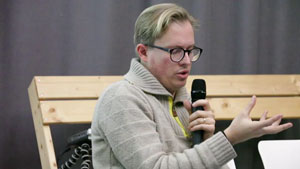
Nicola Setari
Nicola Setari discusses the issues surrounding the work he did for Visionary Africa and his collaboration with architect David Adjaye on GEO-Graphics. The presentation focuses on the itinerancy of Visionary Africa in different African capitals and on the many questions surrounding the representation of African culture within contemporary European institutions. Setari discusses the controversial notion of cultural restitution between European and African countries as well as the politics of working with existing ethnographic collections in Europe.
Synthesis
Visionary Africa · Bruno Latour · Iconoclash: Beyond the Image Wars in Science, Religion, and Art · The whole question of iconoclasm in contemporary culture has been a theme of reflection and investigation · Ausklappen...
Visionary Africa · Bruno Latour · Iconoclash: Beyond the Image Wars in Science, Religion, and Art · The whole question of iconoclasm in contemporary culture has been a theme of reflection and investigation · Brussels: BOZAR Centre for Fine Arts and the Tervuren Museum · An opportunity to reflect on the problem of relations between European museums, ethnographic museums, and the African continent · On one side there was the theme of heritage and on the other side there was the question of visual stereotypes · British-Ghanaian architect, David Adjaye · Book: African Metropolitan Architecture – fifty-four capitals are reorganised according to climate zones on the continent, therefore liberating them of their national identity · The Atlas Research Project: a timeline mapping a hundred years of the evolution of policies on the management of culture on the African continent · GEO-Graphics: part of the bigger project Visionary Africa · Two main exhibitions: GEO-Graphics and A Useful Dream · Using colour codes and labels to decontextualise national identity
Short biography
Nicola Setari, researcher, curator, editor, and professor of visual anthropology at the Milan New Fine Arts and Design Academy. Ausklappen...
Nicola Setari, researcher, curator, editor, and professor of visual anthropology at the Milan New Fine Arts and Design Academy. He was an agent of dOCUMENTA (13) in Kassel, Germany, contributing to the artistic and educational programme. He also co-edited part of the dOCUMENTA (13) catalogue – The Logbook (2012). Between 2006 and 2009, he was editor-in-chief and publisher of the cross-disciplinary art magazine Janus. In 2010 and 2011, he was co-curator of the Visionary Africa platform for the Centre for Fine Arts in Brussels and co-editor of David Adjaye’s GEO-Graphics: A Map of Art Practices in Africa, Past and Present (2010).
Nicola Setari thematisiert und diskutiert Visionary Africa und seine Zusammenarbeit mit dem Architekten David Adjaye für GEO-Graphics. Die Präsentation konzentriert sich auf die Reisen von Visionary Africa in verschiedene afrikanische Hauptstädte und auf die vielen Fragen rund um Repräsentationen afrikanischer Kultur durch zeitgenössische europäische Institutionen. Setari diskutiert kontroverse Zusammenhänge der kulturellen Entschädigung zwischen europäischen und afrikanischen Ländern sowie den Umgang mit ethnografischen Sammlungen in Europa.
Synthese
Visionary Africa · Bruno Latour · Iconoclash: Beyond the Image Wars in Science, Religion, and Art · Die Frage des Ikonoklasmus in der zeitgenössischen Kultur war eine Frage des Nachdenkens und Nachforschens · Ausklappen...
Visionary Africa · Bruno Latour · Iconoclash: Beyond the Image Wars in Science, Religion, and Art · Die Frage des Ikonoklasmus in der zeitgenössischen Kultur war eine Frage des Nachdenkens und Nachforschens · Brüssel: BOZAR Centre for Fine Arts und das Tervuren Museum · Eine Gelegenheit über Probleme in den Beziehungen zwischen europäischen Museen, ethnografischen Museen und dem afrikanischen Kontinent nachzudenken · Einerseits Thema Kulturerbe und andererseits die Frage nach visuellen Stereotypen · British-Ghanaischer Architekt, David Adjaye · Buch: African Metropolitan Architecture – 54 Hauptstädte werden entsprechend den Klimazonen des Kontinentes neu geordnet und so von ihrer nationalen Identität befreit · The Atlas Research Project: Ein Zeitstrahl der Überblick gibt über die hundertjährige Evolution von Kulturmanagementpolitik auf dem afrikanischen Kontinent · GEO-Graphics: Teil des größeren Projektes Visionary Africa · Zwei große Ausstellungen: GEO-Graphics und A Useful Dream · Verwendung von Farbcodes und Etiketten zur Dekonstruktion nationaler Identität
Kurzbiografie
Nicola Setari, Kurator, Redakteur und Professor für visuelle Anthropologie an der New Fine Arts and Design Academy in Mailand. Ausklappen...
Nicola Setari, Kurator, Redakteur und Professor für visuelle Anthropologie an der New Fine Arts and Design Academy in Mailand. Er war ein Agent der dOCUMENTA (13) in Kassel und trug zum künstlerischen Programm und zum Bildungsprogramm bei und zum Documenta-Katalog The Logbook (2012) bei. Zwischen den Jahren 2006 und 2009 war er Chefredakteur des interdisziplinären Kunstmagazins Janus. In den Jahren 2010 und 2011 war er Co-Kurator der Platform Visionary Africa am Centre for Fine Arts in Brüssel und Mitherausgeber von David Adjayes GEO-Graphics: A Map of Art Practices in Africa, Past and Present (2010).
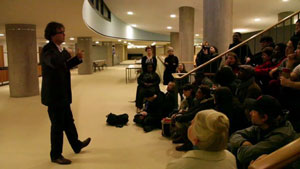
Bernd Scherer
Bernd Scherer presents a brief history of the Haus der Kulturen der Welt (HKW) and speaks of the different projects that the HKW is producing in collaboration with curators, artists, and other practitioners from around the world. The discussion focuses on the role that the HKW has played and how it is reconfiguring itself for the future.
Synthesis
HKW was a gift from the United States to the city of Berlin in 1957 • A symbolic locale in Cold War Berlin • First sign of the West when crossing over from East Berlin • Ausklappen...
HKW was a gift from the United States to the city of Berlin in 1957 • A symbolic locale in Cold War Berlin • First sign of the West when crossing over from East Berlin • Criticism that the HKW was a realm or space defined by the ‘exotic’ • It also played a transmitter role for quite a number of intellectuals and artists • Post-colonial discourse – Homi K. Bhabha, Okwui Enwezor, the Short Century • The Black Atlantic with Paul Gilroy • Third phase of the HKW seeks to encourage an interaction between local and global discourse • What is art, and what are art institutions doing? • The reconceptualisation of the HKW • Global Prayers – working together with academics, artists, and cultural and social activists in cities such as Berlin, Rio de Janeiro, Lagos, Beirut, Istanbul, and Mumbai • Processes of modernisation and secularisation involve removing religion from the picture • 80 researchers in these cities, with different artists • Artist Aernout Mik • The border between scientific and artistic approaches • German Research Foundation (DFG) starting to support workshops in order to develop a conceptual approach to these issues • Whole Earth • How counterculture transforms into big business • After Year Zero • Cultural and political movements in the non-western world
Short biography
Bernd Scherer, director of the Haus der Kulturen der Welt (HKW), holds a doctoral degree in philosophy from the Universität des Saarlandes Ausklappen...
Bernd Scherer, director of the Haus der Kulturen der Welt (HKW), holds a doctoral degree in philosophy from the Universität des Saarlandes and is the author of several publications focusing on aesthetics and international cultural exchange. Previously, he headed the Department of Humanities and Culture at the HKW and has also served as its Deputy Director. He served as Director of the Goethe Institute Mexico from 1999 through 2004 and subsequently as Director of the Arts Department at the Goethe Institute’s headquarters in Munich.
Bernd Scherer spricht über die Geschichte des Haus der Kulturen der Welt (HKW) und verschiedene Projekte die das HKW in Zusammenarbeit mit Kuratoren, Künstlern und anderen internationalen Teilnehmern produziert. Die Diskussion konzentriert sich auf die Rolle des HKW in der Vergangenheit und wo es sich zukünftig sieht.
Synthese
HKW war ein Geschenk der USA an die Stadt Berlin im Jahr 1957 • Ein symbolischer Ort im Berlin des kalten Krieges • Erstes Zeichen des Westens wenn man aus Ostberlin kam • Ausklappen...
HKW war ein Geschenk der USA an die Stadt Berlin im Jahr 1957 • Ein symbolischer Ort im Berlin des kalten Krieges • Erstes Zeichen des Westens wenn man aus Ostberlin kam • Kritik am HKW als Ort, der auf das Exotische setzt • Spielte eine Vermittlerrolle für Intellektuelle und Künstler • Postkolonialer Diskurs – Homi K. Bhabha, Okwui Enwezor • The Short Century • The Black Atlantic mit Paul Gilroy • Dritte Phase des HKW hat zum Ziel, einen Austausch zwischen dem Globalen und dem Lokalen zu ermöglichen • Was ist Kunst und was tun Kunsteinrichtungen? • Global Prayers – Zusammenarbeit mit Wissenschaftlern, Künstlern sowie kulturellen und sozialen Aktivisten in Städten wie Berlin, Rio de Janeiro, Lagos, Beirut, Istanbul und Mumbai • Modernisierungsprozesse und Säkularisierung haben zu Folge, dass die Religion aus dem Blickwinkel verschwindet • 80 Forscher und Künstler in diesen Städten • Künstler Aernout Mik • Die Grenze zwischen wissenschaftlichem und künstlerischem Ansatz • Deutsche Forschungsgemeinschaft beginnt Workshops zu unterstützen um einen konzeptuellen Ansatz zu diesen Fragen zu entwickeln • Whole Earth • Wie verwandelt sich eine kulturelle Opposition in "Big Business"?• After Year Zero • Kulturelle und politische Bewegungen außerhalb der westlichen Welt
Kurzbiografie
Bernd Scherer, Leiter des Haus der Kulturen der Welt erhielt seinen Doktor in Philosophie von der Universität des Saarlandes Ausklappen...
Bernd Scherer, Leiter des Haus der Kulturen der Welt erhielt seinen Doktor in Philosophie von der Universität des Saarlandes und ist Autor mehrerer Publikationen zu Ästhetik und internationalem kulturellen Austausch. Zuvor leitete er die Abteilung für Geisteswissenschaften und Kultur am HKW und war stellvertretender Leiter des Hauses. Von 1999 bis 2004 leitete er das Goethe Institut Mexiko und arbeitete danach als Leiter der Abteilung für Kunst in der Zentrale des Goethe-Institutes in München.
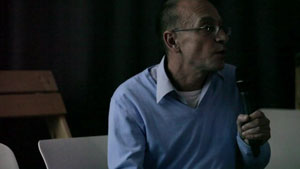
Georges Pfruender
Georges Pfruender explores several issues concerning archives today and their role within society in general, especially in relation to issues such as ethics, colonisation, apartheid in South Africa, the decolonisation of the self, ‘white nostalgia’, and methodological pluralism.
Synthesis
Art institutions as separate entities from universities • The apartheid archives • Revisiting the idea of the archive • Archives command and have their own authority • Ausklappen...
School of Arts at the University of the Witwatersrand • Art institutions as separate entities from universities • The apartheid archives • Revisiting the idea of the archive • Archives command and have their own authority • The archives in South Africa must be visited from that point of view • Who are the archivists? Under what conditions is the archiving processes happening? • How are these archives made available to the public? • Artist William Kentridge • Hesitation around archives • Jacques Derrida - instead of being something solid, the archive should be something that holds us, something unsolved, something that needs to be addressed • Ethics are a core part in whatever we think about archives • An archive not re-performed is not a real archive • ‘White nostalgia’ - an interesting way to think around apartheid archives • Archives have agency and are not innocent things • Decolonisation is not necessarily an act that happens on a territory • How do we decolonise ourselves? • Collective memories and alternative subject positions • Methodological pluralism • Researchers should also be transformed by this process • Jeppe Street – Johannesburg • Difficult to be a migrant in an unstable setting • The sharing of stories, the exchanges of stories
Short biography
Georges Pfruender, head of the Wits School of Arts at the University of the Witwatersrand, Johannesburg, from 2009 to 2013. Ausklappen...
Georges Pfruender, head of the Wits School of Arts at the University of the Witwatersrand, Johannesburg, from 2009 to 2013. From 1996 to 2009, he directed the Institute of Fine Arts, Ecole Cantonale d’Art du Valais (ECAV) in Switzerland, and he was president of the Swiss National Board of Art and Design from 2004 and 2008. As an artist and researcher, he has participated in conferences, panels, and residency programmes in Europe, North and South America, Africa, and Asia, and is presently coordinating collective art projects in collaboration with Cynthia Kros that involve researchers from South Africa, Ethiopia, and France.
Georges Pfruender untersucht verschiedene Aspekte heutiger Archive und deren Rolle innerhalb der Gesellschaft. Insbesondere betrachtet er dabei die Beziehung zu Themengebieten wie Ethik, Kolonialisierung, Apartheid in Südafrika, Dekolonialisierung des Selbst, „weiße Nostalgie“ und methodologischer Pluralismus.
Synthese
Kunstinstitutionen als von Universitäten unabhängige Einheiten • Neubetrachtung des Apartheid-Archivs • Archive haben ihre eigene Autorität • Ausklappen...
Kunstinstitutionen als von Universitäten unabhängige Einheiten • Neubetrachtung des Apartheid-Archivs • Archive haben ihre eigene Autorität • Archive in Südafrika müssen von dieser Perspektive aus betrachtet werden • Wer sind die Archivare? Unter welchen Bedingungen laufen Archivierungsprozesse ab? • Wie werden Archive der Öffentlichkeit zugänglich gemacht? • Künstler William Kentridge • Zögern beim Thema Archive • Jacques Derrida – statt statisch zu sein, sollte das Archiv etwas sein das uns trägt, etwas ungelöstes, etwas das thematisiert werden muss • Ethik steht im Zentrum des Nachdenkens über Archive • Ein Archiv das nicht aktiviert wird ist kein echtes Archiv • ‘Weiße Nostalgie’ – eine interessante Betrachtungsweise des Apartheid-Archivs • Archive haben Handlungsmacht und sind keine unschuldigen Dinge • Dekolonialisierung ist nicht etwas das nur auf einem bestimmten Gebiet passiert • Wie dekolonisieren wir uns selbst? • Kollektive Erinnerungen und alternative Subjektpositionen • Methodologischer Pluralismus • Forscher sollen von diesem Prozess verändert werden • Jeppe Street – Johannesburg • Schwierig, Migrant in einer instabilen Situation zu sein • Teilen und Austausch von Geschichten
Kurzbiografie
Georges Pfruender, Leiter der Wits School of Arts an der University of the Witwatersrand, in Johannesburg von 2009 bis 2013. Ausklappen...
Georges Pfruender, Leiter der Wits School of Arts an der University of the Witwatersrand, in Johannesburg von 2009 bis 2013. Zwischen 1996 und 2009 leitete er das Institut für bildende Kunst an der Ecole Cantonale d’Art du Valais (ECAV) in der Schweiz und war von 2004 bis 2008 Vorsitzender des Schweizer Rat für Kunst und Design. Als Künstler und Wissenschaftler nahm er an Konferenzen, Talks und Residencyprogrammen in Europa, Nord- und Südamerika, Afrika und Asien teil. Aktuell koordiniert er ein kollektives Kunstprojekt in Zusammenarbeit mit Cynthia Kros mit Forschern und Wissenschaftlern aus Südamerika, Äthiopien und Frankreich.
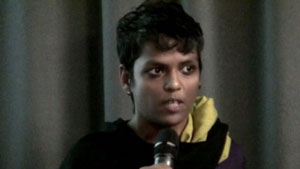
Natasha Mendonca
Natasha Mendonca presents her work and explores her different approaches to investigating the relation between life and art, especially through non-orthodox art practices and a queer political standpoint.
Synthesis
Colonisation of India • England and Portugal • Difficulties of being raised Catholic in India • Not learning about one’s own culture • Cultural schisms • Growing up queer and Catholic in India • Ausklappen...
Colonisation of India • England and Portugal • Difficulties of being raised Catholic in India • Not learning about one’s own culture • Cultural schisms • Growing up queer and Catholic in India • The creation of a festival to explore issues of gender and sexuality • Facing problems with the law for running such a festival • Political activism • Understanding the world through art • Travelling to other cultures to find links • Healing through collective experience • Relating cultural experiences from other countries • Working with food as art practice • Questioning the white cube experience • Colonisation from different perspectives • Art that explores the concept of archive
Natasha Mendonca präsentiert ihre Arbeit und spricht über ihre unterschiedlichen Ansätze zur Erforschung der Beziehung zwischen Leben und Kunst – insbesondere mit unorthodoxen Kunstpraktiken und einer queeren politischen Haltung.
Synthese
Kolonialisierung Indiens • England und Portugal • Die Probleme einer katholischen Erziehung in Indien • Nichts über die eigene Kultur lernen • Kulturspaltung • Queer und katholisch in Indien aufwachsen • Ausklappen...
Kolonialisierung Indiens • England und Portugal • Die Probleme einer katholischen Erziehung in Indien • Nichts über die eigene Kultur lernen • Kulturspaltung • Queer und katholisch in Indien aufwachsen • Ein Festival schaffen das Fragen nach Gender und Sexualität thematisiert • Rechtliche Probleme die mit der Schaffung dieses Festival auftauchen • Politischer Aktivismus • Die Welt durch Kunst verstehen • In andere Kulturen reisen um Verbindungen zu finden • Heilung durch kollektive Erfahrung • Kulturelle Erfahrungen aus anderen Ländern zuordnen • Arbeit mit Essen als künstlerische Praxis • Die White Cube Erfahrung hinterfragen • Kolonialisierung aus verschiedenen Perspektiven • Kunst, die das Archivkonzept untersucht
Kurzbiografie
Natasha Mendonca, Filmemacherin und bildende Künstlerin. Trotz der strengen indischen Zensurgesetze gegen Homosexualität, war sie 2013 Mitbegründerin von Larzish, Ausklappen...
Natasha Mendonca, Filmemacherin und bildende Künstlerin. Trotz der strengen indischen Zensurgesetze gegen Homosexualität, war sie 2013 Mitbegründerin von Larzish, dem ersten internationalen indischen Film- und Videofestival, zu den Themen Sexualität und Gender in Bombay. Ihre vorhergegangene Arbeit Jan Villa wurde 2011 mit dem Tiger Award des International Film Festivals in Rotterdam ausgezeichnet sowie unter anderem auch 2011 zum Besten Film der Experimenta in Indien gewählt. Ihr erster Spielfilm Ajeeb Aashiq beschäftigt sich mit Aspekten von Gender, Arbeit und Klasse in Bombay. Der Film wurde 2011 von der Hubert Bals Stiftung unterstützt und als Beitrag für Open Doors beim Locarno Film Festival im Jahr 2011 ausgewählt.
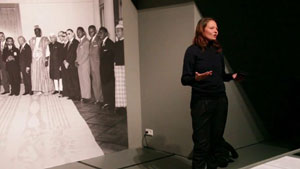
Doreen Mende
Doreen Mende presents her work related to the Travelling Communiqué project in collaboration with the Haus der Kulturen der Welt (HKW) and the Museum of Yugoslav History. This work focuses on photo archives, including the presidential press service archive of Tito. The project, which explores the Yugoslav perspective on the Non-Aligned Movement, raises many issues, such as globalisation, politics of inclusion, the use of images in political movements, and colonialism.
Synthesis
Travelling Communiqué • HKW • Long-term, collaborative research project • Artist Milica Tomić • Museum of Yugoslav History • The presidential press service archive of Tito • The Otolith Group • Ausklappen...
Travelling Communiqué • HKW • Long term, collaborative research project • Artist Milica Tomic • Museum of Yugoslav History • The presidential press service archive of Tito • The Otolith Group • The Dutch Art Institute • The Non-Aligned Movement, its first conference in Belgrade from September 1–5, 1961 • Why deal with this topic in an era of globalisation • Politics of inclusion by a condition of permanent war • Tito’s affinity with images • Tito’s construction of a cinema in the Museum of Yugoslav History • Image production a crucial instrument of militant cinema vs. an instrument to continue an independence movement • How can we make use of this archival material in the context of the HKW? • Interventions into the historical material • What could be the Ethiopian horizon in the Non-Aligned Movement? • The first conference of the African Union in 1963 • The film Blood Is Not Fresh Water – suggesting a way of reading history through different culture rituals • Different concepts of history • The document as a historical indication of a moment • The inner split that appears or emerges in the figure of Tito • The ambivalent or paradoxical situation between independence movement and structure of the state • The impact colonialism had on the particular countries on the African continent • We are not working only with the archive presidential press service • Relating to these historical moments via images, speeches, and films • The Non-Aligned Movement still going today – hosted by Iran • This power or force is not like the master plan for a new world order or for another universalism
Short biography
Doreen Mende, curator interested in theoretical and practical issues of exhibiting with regard to space and geopolitics. Ausklappen...
Doreen Mende, curator interested in theoretical and practical issues of exhibiting with regard to space and geopolitics. In 2011, she was a fellow of the Arab Image Foundation in Beirut. She completed her practice-based PhD at Goldsmiths in 2013. She is co-founder of the publication series Displayer at HfG/ZKM in Karlsruhe and currently teaches at the Dutch Art Institute. With Milica Tomic, Armin Linke, and other authors, she is currently working on the project Travelling Communiqué, which discusses the topicalities of the Yugoslav Presidential Press Service / Photo Section in Belgrade during Tito’s presidency from 1948 to 1980.
Doreen Mende präsentiert ihre Arbeit die im Rahmen des Travelling Communiqué Projektes in Zusammenarbeit mit dem Haus der Kulturen der Welt (HKW) und dem Museum für Jugoslawische Geschichte entstanden ist. Diese Arbeit beschäftigt sich mit Fotoarchiven, so auch dem präsidentiellen Pressedienstarchiv unter Tito. Das Projekt untersucht die jugoslawische Perspektive der Bewegung der blockfreien Staaten und stellt Fragen u.a. zu Globalisierung, Inklusionspolitik, der Verwendung von Bildern in politischen Bewegungen und zu Kolonialismus.
Synthese
Travelling Communiqué • HKW • Auf lange Zeit angelegtes kollaboratives Forschungsprojekt • Künstlerin Milica Tomić • Museum of Yugoslav History • Das präsidentielle Pressebildarchiv unter Tito • The Otolith Group • Ausklappen...
Travelling Communiqué • HKW • Auf lange Zeit angelegtes kollaboratives Forschungsprojekt • Künstlerin Milica Tomic • Museum of Yugoslav History • Das präsidentielle Pressebildarchiv unter Tito • The Otolith Group • The Dutch Art Institute • Bewegung der blockfreien Staaten, sowie dessen erste Konferenz in Belgrad vom 1. bis 5. September 1961 • Warum sollte man sich mit diesem Thema während einer Zeit der Globalisierung befassen? • Politik der Inklusion durch einen permanenten Kriegszustand • Titos Affinität zu Bildern • Titos Bau eines Kinos im Museum für jugoslawische Geschichte • Bildproduktion als wichtiges Element eines militanten Kinos vs. als ein Instrument mit dem eine unabhängige Bewegung fortgeführt wird • Wie können wir dieses Archivmaterial im Rahmen des HWK nutzen? • Interventionen im historischen Material • Was könnte der äthiopische Horizon innerhalb der Bewegung der blockfreien Staaten sein? • Die erste Konferenz der Afrikanischen Union im Jahr 1963 • Der Film Blood Is Not Fresh Water – Vorschlag einer historischen Lesart durch kulturspezifische Rituale • Verschiedene Geschichtskonzepte • Dokumente als historische Indikatoren eines Moments • Die innere Zerrissenheit, die sich in der Figur von Tito zeigt • Die Ambivalenz oder paradoxe Situation zwischen unabhängigen Bewegungen und der staatlicher Struktur • Der Einfluss des Kolonialismus auf spezifische Länder des afrikanischen Kontinentes • Wir arbeiten nicht ausschließlich mit dem Archiv des präsidentiellen Pressedienstes • Sich auf diese historischen Momente durch Bilder, Rede und Film beziehen • Die Bewegung der blockfreien Staaten existiert auch heute noch – mit dem Gastgeber Iran • Diese Macht oder Kraft ist nicht gleichsetzbar mit einem Masterplan für eine neue Weltordnung oder einen anderen Universalismus
Kurzbiografie
Doreen Mende, Kuratorin, interessiert sich für praktische und theoretische Ausstellungsaspekte mit Fokus auf Raum und Geopolitik. Ausklappen...
Doreen Mende, Kuratorin, interessiert sich für praktische und theoretische Ausstellungsaspekte mit Fokus auf Raum und Geopolitik. Im Jahr 2011 war sie Fellow der Arab Image Foundation in Beirut. Im Jahr 2013 schloss sie einen praktischen PhD am Goldsmiths College London ab. Sie ist Mitbegründerin der Publikationsreihe Displayer an der HfG/ZKM in Karlsruhe und unterrichtet momentan am Dutch Art Institute. Aktuell arbeitet sie mit Milica Tomic, Armin Linke und anderen Autoren am Projekt Travelling Communiqué, das sich mit der Aktualität vom Bilddienst des Jugoslawischen Präsidentiellen Pressedienstes in Belgrad während Titos Präsidentschaftszeit von 1948 bis 1980 auseinandersetzt.
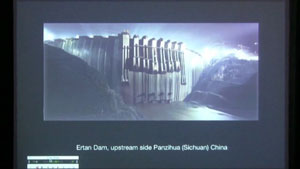
Armin Linke
Armin Linke presents his work, which focuses on questions of how to employ and think with images, especially from an archival perspective. He also discusses the relation between the Internet and architectural space, looking at the anthropological use of architecture.
Synthesis
Different ways to think and work with images • HfG Karlsruhe / ZKM • Project collaboration with Doreen Mende and Wilfried Kühn • Architettura • Collaboration with Alex Rich and Peter Hanappe • Ausklappen...
Different ways to think and work with images • HfG Karlsruhe / ZKM • Project collaboration with Doreen Mende and Wilfred Kühn • Architettura • Collaboration with Alex Rich and Peter Hanappe • Sony CSL Lab • Insurance companies do not insure artwork that can be touched • Oscar Niemeyer • Early project: an online image archive – shown at the Utopia Station, Venice Biennale • To bring the structure of the internet into the architectural space • Carlo Mollino • Anthropological use of architecture • The changing landscape of rural Italy through architecture • Bruno Latour • An Inquiry Into Modes of Existence • Phenotypes/Limited Forms • Performative installation • Using an algorithm to select the images • MMK – Museum für Moderne Kunst, Frankfurt a.M. • Making History • Corrado Calvo
Short biography
Armin Linke, artist working with film and photography, with an ongoing archive on human activity and natural and manmade landscapes. Ausklappen...
Armin Linke, artist working with film and photography, with an ongoing archive on human activity and natural and manmade landscapes. He is a professor at the HfG (Hochschule für Gestaltung) Karlsruhe, a guest professor in Arts and Design at the IUAV University in Venice, and a research affiliate at MIT Visual Arts Program Cambridge. He co-curated the project Double Bound Economies (2013), and together with Territorial Agency and Anselm Franke, he conceptualised and executed the Anthropocene Observatory video series at Haus der Kulturen der Welt, Berlin. Linke is also a part of Travelling Communiqué: Reading a Photo Archive (1948-1980).
Armin Linke präsentiert seine Arbeit mit einem Schwerpunkt auf Fragen wie man mit Bildern denken und arbeiten kann, besonders aus einer archivischen Perspektive. Er diskutiert außerdem auch die Beziehung zwischen Internet und architektonischem Raum und betrachtet hierbei die anthropologische Verwendung von Architektur.
Synthese
Unterschiedliche Arten mit Bildern zu denken und zu arbeiten • HfG Karlsruhe / ZKM • Projektzusammenarbeit mit Doreen Mende und Wilfried Kühn • Architettura • Ausklappen...
Unterschiedliche Arten mit Bildern zu denken und zu arbeiten • HfG Karlsruhe / ZKM • Projektzusammenarbeit mit Doreen Mende und Wilfred Kühn • Architettura • Zusammenarbeit mit Alex Rich und Peter Hanappe • Sony CSL Lab • Versicherungen versichern keine Kunstwerke die berührt werden dürfen • Oscar Niemeyer • Frühes Projekt: Ein Online Bildarchiv – gezeigt in der Utopia Station, Venice Biennale • Die Struktur des Internets in den architektonischen Raum bringen • Carlo Mollino • Anthropologische Verwendung von Architektur • Die sich durch Architektur verändernde Gestalt des ländlichen Italiens • Bruno Latour • An Inquiry Into Modes of Existence • Phenotypes/Limited Forms • Performative Installation • Verwendung eines Algorithmus zur Auswahl von Bildern • Museum für Moderne Kunst, Frankfurt a.M. • Making History • Corrado Calvo
Kurzbiografie
Armin Linke, Künstler. Er ist Professor an der HfG (Hochschule für Gestaltung) Karlsruhe, Ausklappen...
Armin Linke, Künstler. Er ist Professor an der HfG (Hochschule für Gestaltung) Karlsruhe, Gastprofessor für Kunst und Design an der IUAV Universität in Venedig und am MIT Visual Arts Program in Cambridge, USA. Er co-kuratierte das Projekt Double Bound Economies (2013) und konzeptualisierte und realisierte zusammen mit Territorial Agency und Anselm Franke die Anthropocene Observatory Videoreihe am Haus der Kulturen der Welt in Berlin. Linke ist außerdem Teil von Travelling Communiqué: Reading a Photo Archive (1948-1980).
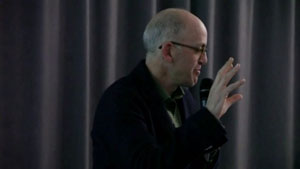
Jonathan Ledgard
Jonathan Ledgard raises several questions in relation to the arrival of new technologies and infrastructures in Africa and how these have an impact on African development, both culturally and politically. He also discusses how these technologies bring with them foreign interests and expectations, which have a direct effect on Africa as a whole.
Synthesis
Big ideas about archiving and memory • Working for The Economist • Joining love of Africa, technology, and creativity • The archiving of the human brain – reverse engineering • The Merowe people of Sudan have their archive in the elements • Ausklappen...
Big ideas about archiving and memory • Working for The Economist • Joining love of Africa, technology, and creativity • The archival of the human brain – reverse engineering • The Merowe people of Sudan have their archive in the elements • Technology is not the be-all and end-all • A youthful China shakes hands with a shy Africa • The Nokia 1100 – the most influential technology in Africa in the last fifty years • Life recording – an entire life compressed and stored • IBM predicts a tsunami of data • How will future generations of Africans relate to their past? • Africa has a history of non-archival practice • Digital data implies the recording of the present • Attitudes toward Africa will have to change in the future • The dangers of digital identities being controlled by the state and corporations
Short biography
Jonathan Ledgard, thinker on near future nature, technology, and politics. Director of the Afrotech initiative at the Swiss Federal Institute of Technology in Lausanne, Ausklappen...
Jonathan Ledgard, thinker on near future nature, technology, and politics. Director of the Afrotech initiative at the Swiss Federal Institute of Technology in Lausanne, where he works to pioneer advanced technologies on a massive scale in Africa through projects including the development of virtual coins and cargo robots. A long-time Africa correspondent for The Economist who has reported stories from 50 countries and on several wars, he is the author of two critically acclaimed novels, Giraffe (2006) and Submergence (2013).
Jonathan Ledgard hinterfragt die Einführung neuer Technologien und Infrastrukturen in Afrika und wie diese die Entwicklung in Afrika sowohl kulturell als auch politisch beeinflussen. Er diskutiert außerdem auf welche Weise diese Technologien fremde Interessen und Erwartungen mit sich bringen, die einen direkten Einfluss auf Afrika als Ganzes haben.
Synthese
Große Vorstellungen zu Archivierung und Erinnerung • Arbeit für The Economist • Verbindung einer Liebe zu Afrika, Technologie und Kreativität • Die Archivierung des menschlichen Gehirns – umgekehrte Konstruktion • Ausklappen...
Große Vorstellungen zu Archivierung und Erinnerung • Arbeit für The Economist • Verbindung einer Liebe zu Afrika, Technologie und Kreativität • Die Archivierung des menschlichen Gehirns – umgekehrte Konstruktion • Das Merowe Volk aus Sudan hat sein Archiv in den Elementen • Technologie ist nicht die Lösung aller Dinge • Ein jugendliches China und ein schüchternes Afrika schütteln sich die Hände • Das Nokia 1100 – die einflussreichste Technologie der letzten 50 Jahre in Afrika • Aufnahmen vom Leben – ein gesamtes Leben komprimiert und gespeichert • IBM sagt einen Datentsunami voraus • Welche Beziehung werden die zukünftigen Generationen in Afrika zu ihrer Vergangenheit haben? • Afrika hat eine Geschichte nicht-archivierender Praktiken • Digitale Daten implizieren eine Aufnahme der Gegenwart • Einstellungen gegenüber Afrika werden sich in Zukunft ändern müssen • Die Gefahr, dass digitale Identitäten vom Staat und von Firmen kontrolliert werden
Kurzbiografie
Jonathan Ledgard denkt über die Themen Natur, Technologie und Politik in naher Zukunft nach. Als Direktor der Afrotech Initiative am Swiss Federal Institute of Technology in Lausanne, Ausklappen...
Jonathan Ledgard denkt über die Themen Natur, Technologie und Politik in naher Zukunft nach. Als Direktor der Afrotech Initiative am Swiss Federal Institute of Technology in Lausanne, arbeitet er daran, fortgeschrittene Technologien im großangelegten Pionierprojekt in Afrika einzusetzen. Projekte die das ermöglichen sollen sind unter anderem die Entwicklung virtueller Münzen und Lastenroboter. Als langjähriger Afrikakorrespondent für The Economist, der Geschichten aus 50 Ländern und zu verschiedenen Kriegssituationen berichtete, ist er außerdem Autor zweier von der Kritik gefeierten Romane, Giraffe (2006) und Submergence (2013).
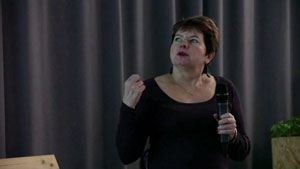
Cynthia Kros
Cynthia Kros speaks about the Apartheid Archive in South Africa and the issues that surround the formation and reception of such an institution. Her presentation raises questions in relation to memory and the urban space, especially with regard to the instalment of public sculptures, as well as questions in relation to the Truth and Reconciliation Commission, and how to bring personal stories to light.
Synthesis
The Apartheid Archives in South Africa • The issues of reading such an archive that was generated by those in power • How to memorialise the oppressed? • Brenda Fassie • Ausklappen...
The Apartheid Archives in South Africa • The issues of reading such an archive that was generated by those in power • How to memorialise the oppressed? • Brenda Fassie • The role of large statues in generating and fixating memories • Changing street names as a political tool • Hector Pieterson Memorial and Museum • The personal stories of ordinary people – how to keep them? • The acceptance of different kinds of truth • The complexity of truth and its relation to a historical archive • The Truth and Reconciliation Commission • Bringing personal stories to light
Short biography
Cynthia Kros, historian, heritage specialist, and professor at the University of the Witwatersrand, Johannesburg. Ausklappen...
Cynthia Kros, historian, heritage specialist, and professor at the University of the Witwatersrand, Johannesburg. Among other subjects, her research focuses on South African memorials and oral history. Her selected publications include the South African Historical Journal, for which she has served as co-editor since 2006, Great People, Great Places (2009), and The Seeds of Separate Development: Origins of Bantu Education (2010).
Cynthia Kros spricht über das Apartheid-Archiv in Südafrika. Sie thematisiert aktuelle Probleme der Gestaltung einer solchen Institution und welche Reaktion dabei ausgelöst werden. Ihre Präsentation berührt Fragen zu Erinnerung und urbanem Raum, besonders in Bezug öffentliche Skulpturen und Installationen. Sie beschäftig sich mit Wahrheits- und Versöhnungskommissionen, und wie diese persönliche Geschichten ans Licht bringen.
Synthesis
The Apartheid Archives in South Africa • Die Probleme beim Lesen eines solchen Archives, das von den Machthabern geschaffen wurde • Wie erinnert man an die Unterdrückten? • Brenda Fassie • Ausklappen...
The Apartheid Archives in South Africa • Die Probleme beim Lesen eines solchen Archives, das von den Machthabern geschaffen wurde • Wie erinnert man an die Unterdrückten? • Brenda Fassie • Die Rolle großer Statuen bei der Schaffung und Fixierung von Erinnerungen • Das Ändern von Straßennamen als politisches Werkzeug • Hector Pieterson Memorial and Museum • Die persönlichen Geschichten normaler Mernschen – wie können sie bewahrt werden? • Das Akzeptieren verschiedener Arten von Wahrheit • Die Komplexität von Wahrheit und deren Beziehung zu einem historischen Archiv • Die Wahrheits- und Versöhnungskommission • Persönliche Geschichten ans Licht bringen
Kurzbiografie
Cynthia Kros, Historikerin, Spezialistin für Denkmäler und Professorin an der University of the Witwatersrand, Johannesburg. Ausklappen...
Cynthia Kros, Historikerin, Spezialistin für Denkmäler und Professorin an der University of the Witwatersrand, Johannesburg. Unter anderem beschäftigt sich ihre Forschung mit südafrikanischen Denkmälern und mündlich überlieferter Geschichte. Ihre ausgewählten Publikationen umfassen das South African Historical Journal für welches sie als Mitherausgeberin seit 2006 tätig ist, Great People, Great Places (2009), und The Seeds of Separate Development: Origins of Bantu Education (2010).
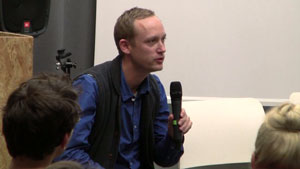
Tue Greenfort
Tue Greenfort presents on his recent projects, especially his work with water and an international water archive, as well as how this helps to understand changing landscapes and open dialogues on subjects such as biozone protection and the relation between computer science and thought.
Synthesis
dOCUMENTA (13) • Multi-species archive – human and non-human animals • Water archive • Water pollution and drinkability • Ausklappen...
Danish artist living in Berlin • dOCUMENTA (13) • Multi-species archive – human and non-human animals • Water archive • Water pollution and drinkability • Place specific – samples from around the world • Symbolic value of objects • Closed ecosystem • What is the difference between an archive and a collection? • A collection that opens dialogue • Water as a political issue • Different approaches to water • Exhibition at SculptureCenter in New York • Hurricane Sandy • Reaction to the hurricane • The changing landscape of New York • How to re-think the environment in an urban area • The horseshoe crab • Evolutionary time scale • Dialogue on biozone protection • New York context • The relation between computer science and ecological thought
Short biography
Tue Greenfort, artist. As a participant in dOCUMENTA (13) in Kassel, Germany, Greenfort was co-curator of an archive on multi-species co-evolution, The Worldly House. Ausklappen...
Tue Greenfort, artist. As a participant in dOCUMENTA (13) in Kassel, Germany, Greenfort was co-curator of an archive on multi-species co-evolution, The Worldly House. Solo presentations include Berlinische Galerie (2012), South London Gallery (2011), Kunstverein Braunschweig (2008), and Secession, Vienna (2007). Among his publications, the most comprehensive, Linear Deflection, was published by Walther König in 2009.
Tue Greenfort spricht über seine aktuellen Projekte, besonders seine Arbeit mit Wasser und seine Initiative für ein internationales Wasserarchiv. Außerdem thematisiert er, wie dies uns hilft, sich verändernde Landschaften zu verstehen und Diskurse zu Themen wie Biozonenschutz oder zu der Beziehung zwischen Computerwissenschaften und Theorie zu öffnen.
Synthese
dOCUMENTA (13) • Multispezies Archiv - menschliche und nichtmenschliche Tiere • Wasserarchiv • Wasserverschmutzung und Trinkbarkeit • Ausklappen...
Dänischer Künstler der in Berlin wohnt • dOCUMENTA (13) • Multispezies Archiv - menschliche und nichtmenschliche Tiere • Wasserarchiv • Wasserverschmutzung und Trinkbarkeit • Ortsspezifisch – Proben von überall auf der Welt • Symbolischer Wert von Objekten • Geschlossene Ökosysteme • Was ist der Unterschied zwischen einem Archiv und einer Sammlung? • Eine Sammlung, die Dialoge eröffnet • Wasser als Politikum • Unterschiedliche Ansätze zum Thema Wasser • Ausstellung im SculptureCenter in New York • Hurrikan Sandy • Reaktionen auf den Hurrikan • Die sich verändernde Landschaft New Yorks • Wie denkt man die Umgebung in einer urbanen Gegend neu? • Der Pfeilschwanzkrebs • Evolutionärer Zeitrahmen • Dialog über Biozonenschutz • New York als Kontext • Die Beziehung zwischen Computerwissenschaft und ökologischen Gedanken
Kurzbiografie
Tue Greenfort, Künstler. Als ein Teilnehmer der dOCUMENTA (13) in Kassel war Greenfort Ko-Kurator eines Archivs für spezienübergreifende Ko-Evolution, The Worldly House. Ausklappen...
Tue Greenfort, Künstler. Als ein Teilnehmer der dOCUMENTA (13) in Kassel war Greenfort Ko-Kurator eines Archivs für spezienübergreifende Ko-Evolution, The Worldly House. Soloschauen seiner Werke umfassen die Berlinische Galerie (2012), die South London Gallery (2011), den Kunstverein Braunschweig (2008), und Secession, Wien (2007). Die umfangreichste seiner Publikationen, Linear Deflection, wurde von Walther König im Jahr 2009 herausgegeben.

Elizabeth Giorgis
Elizabeth Giorgis focuses on the progressive loss of city archives in Addis Ababa due to the rapid modernisation of the city and questions the place and role of young artists in this transformation. She examines the effects that these transformations have on the local communities and how artists’ works can draw attention to these changes. She presents and discusses the work of artists Michael Tesfaye, Mihret Kebede, and Berhanu Ashagrie Deribew.
Synthesis
The Institute of Ethiopian Studies • The manipulation of archives • Addis Ababa undergoing urban transformation • Archives being erased as a result • Ausklappen...
The Institute of Ethiopian Studies • The manipulation of archives • Addis Ababa undergoing urban transformation • Archives being erased as a result • Young artists questioning their identity in relation to the past of Addis Ababa • European colonialists tried to erase African archives • The Chinese are attempting to do the same • Africa transcends • Artist Michael Tesfaye • How to talk about the future being disconnected from the past • City’s future development contrasted against its poorer past and present • Indigenous structures replaced by poor quality modern constructions • Communities being dismantled • Cemeteries cleared to make way for roads • Menelik Palace • Power existing alongside poverty • Clearing areas for development • The effects this has on the local population • Artist Mihret Kebede • The hidden and the apparent • Powerful work of performance by young artists in Addis Ababa • Questioning the use of advertising in the public space • Artist Berhanu Ashagrie Deribew • The interchange of space and place • The homogenisation of public space according to international aesthetic standards • Real censorship vs. self-censorship • The Changing DNA of Addis Ababa – Goethe-Institut
Short biography
Elizabeth Giorgis, art historian, professor, and preeminent scholar on the subject of Ethiopian art and culture. Ausklappen...
Elizabeth Giorgis, art historian, professor, and preeminent scholar on the subject of Ethiopian art and culture. She holds a PhD from the Department of History of Art and Visual Studies of Cornell University, an MA in Museum Studies from New York University, and has written extensively on Ethiopian art. As a curator, Giorgis has presented exhibitions at the Modern Art Museum and the Museum of the Institute of Ethiopian Studies, both in Addis Ababa. She was most recently a Visiting Professor in the Humanities at the Cogut Center at Brown University, Providence, USA.
Elizabeth Giorgis konzentriert sich auf den Verlust von Stadtarchiven in Addis Abeba als Folge der schnell fortschreitenden Modernisierung der Stadt und hinterfragt die Position und Rolle junger Künstler innerhalb dieses Wandels. Sie untersucht die Folgen, welche diese Veränderungen für lokale Gemeinschaften haben und fragt wie künstlerische Arbeit Aufmerksamkeit auf diese Veränderungen ziehen kann. Sie präsentiert und diskutiert die Arbeit der Künstler Michael Tesfaye, Mihret Kebede und Berhanu Ashagrie Deribew.
Synthese
The Institute of Ethiopian Studies • Die Manipulation des Archivs • Addis Abeba erlebt eine urbane Transformation • Als Folge werden Archive ausgelöscht • Ausklappen...
The Institute of Ethiopian Studies • Die Manipulation des Archivs • Addis Abeba erlebt eine urbane Transformation • Als Folge werden Archive ausgelöscht • Junge Künstler hinterfragen ihre Identität in Bezug auf Addis Abebas Vergangenheit • Europäische Kolonialisten haben versucht afrikanische Archive auszulöschen • Chinesen versuchen dasselbe • Afrika transzendiert • Künstler Michael Tesfaye • Wie kann man über die Trennung zwischen Zukunft und Vergangenheit sprechen? • Zukünftige Entwicklungen der Stadt im Kontrast zu seiner ärmeren Vergangenheit und Gegenwart • Indigene Strukturen werden von qualitative minderwertigen modernen Bauvorhaben ersetzt • Gemeinschaften werden auseinandergenommen • Friedhöfe werden geräumt um Platz für Straßen zu machen • Menelik Palace • Macht die neben Armut existiert • Orte für Stadtentwicklung räumen • Der Einfluss, den dies auf die Bevölkerung vor Ort hat • Künstlerin Mihret Kebede • Das Versteckte und das Offensichtliche • Wirkungsstarke Performancearbeiten junger Künstler in Addis Abeba • Hinterfragen der Verwendung von Werbung im öffentlichen Raum • Der Künstler Berhanu Ashagrie Deribew • Der Austausch von Raum und Ort • Die Homogenisierung des öffentlichen Raums nach internationalen ästhetischen Standards • Echte Zensur versus Selbstzensur • The Changing DNA of Addis Ababa – Goethe Institut
Kurzbiografie
Elizabeth Giorgis, Kunstgeschichtlerin, Professorin und Wissenschaftlerin auf dem Gebiet äthiopischer Kunst und Kultur. Ausklappen...
Elizabeth Giorgis, Kunstgeschichtlerin, Professorin und herausragende Wissenschaftlerin auf dem Gebiet äthiopischer Kunst und Kultur. Sie hat einen PhD vom Institut für Kunstgeschichte und Bildstudien der Cornell University, einen MA in Museumskunde der New York University und hat ausgiebig zu äthiopischer Kunst geschrieben. Als Kuratorin präsentierte Giorgis Ausstellungen am Modern Art Museum und dem Museum of the Institute of Ethiopian Studies, beides in Addis Abeba. Sie ist Gastprofessorin für Geisteswissenschaften am Cogut Center der Brown University in Providence, USA.
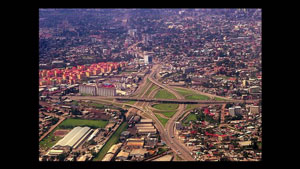
Fasil Giorghis
Fasil Giorghis presents the issues facing Addis Ababa and its rapid transformation in the 21st century, touching on themes of colonisation, archival culture, and memory preservation.
Synthesis
The importance of archives in the work of architects, city planners, and thinkers • Images of the rapid transformation of Addis Ababa • Tabula rasa approach to development in some areas • Ausklappen...
The importance of archives in the work of architects, city planners, and thinkers • Images of the rapid transformation of Addis Ababa • Tabula rasa approach to development in some areas • Anti-neoliberal policies in Addis Ababa • Western style training in architecture, no focus on local culture • Description of the history of Addis Ababa from 125 years ago • Images of Addis Ababa from European archives • The opening of the country to foreign influence after 1000 years • The Italian invasion of 1936 and its effects • Architecture and planning as tools of colonisation • Addis Ababa is not a segregated city, but segregation is developing • ‘Red Terror’ Martyrs’ Memorial Museum • Rescuing historic buildings • The role of archives in the ongoing debate for cultural preservation
Short biography
Fasil Giorghis, architect and chair of conservation of urban and architectural heritage at EiABC, Addis Ababa University. Ausklappen...
Fasil Giorghis, architect and chair of conservation of urban and architectural heritage at EiABC, Addis Ababa University. He has worked on the study and preservation of the architectural heritage of Ethiopia, from traditional housing to historic towns. In 2008, he published a book entitled Addis Ababa: The City and its Urban and Architectural Heritage from 1886-1941. He has designed hotels, cultural centres, commercial buildings, and private residences around the country, including the ‘Red Terror’ Martyrs’ Memorial Museum in Addis Ababa. Typical of his designs are the use of local materials and indigenous knowledge combined with a great concern for his designs’ impact on the environment.
Fasil Giorghis spricht über die Probleme, mit denen Addis Abeba angesichts seiner schnellen Veränderungen im 21. Jahrhundert zu kämpfen hat. Weitere Themen sind hierbei Kolonialisierung, Archivkulturen und Erinnerungsbewahrung.
Synthese
Die Bedeutsamkeit von Archiven für die Arbeit von Architekten, Stadtplanern und Theoretikern • Bilder des schnellen Wandels in Addis Abeba • Tabula rasa Ansatz für die Entwicklung einiger Gegenden • Ausklappen...
Die Bedeutsamkeit von Archiven für die Arbeit von Architekten, Stadtplanern und Theoretikern • Bilder des schnellen Wandels in Addis Abeba • Tabula rasa Ansatz für die Entwicklung einiger Gegenden • Anti-neoliberale Politik in Addis Abeba • Westlich orientierte Ausbildung in Architektur, kein Focus auf lokale Kultur • Beschreibung der Geschichte Addis Abebas ab einem Zeitpunkt von vor 125 Jahren • Bilder von Addis Abeba aus europäischen Archiven • Die Öffnung des Landes für fremde Einflüsse nach 1000 Jahren • Die italienische Invasion von 1936 und ihre Folgen • Architektur und Planung als Werkzeuge der Kolonialisierung • Addis Abeba ist keine geteilte Stadt, aber Rassentrennung nimmt zu • ‘Red Terror’ Martyrs’ Memorial Museum • Rettung historischer Gebäude • Die Rolle von Archiven in der aktuellen Debatte zu kultureller Bewahrung
Kurzbiografie
Fasil Giorghis ist Architekt und Konservator für urbane und architektonische Denkmäler an der EiABC Addis Ababa University. Ausklappen...
Fasil Giorghis ist Architekt und Konservator für urbane und architektonische Denkmäler an der EiABC Addis Ababa University. Er hat zur Erforschung und Erhaltung von Architekturdenkmälern in Äthiopien gearbeitet, von traditionellen Häusern bis hin zu historischen Städten. Im Jahr 2008 veröffentlichte er ein Buch mit dem Titel Addis Ababa: The City and its Urban and Architectural Heritage from 1886-1941. Er hat Hotels, Kulturzentren, kommerzielle Gebäude und private Wohnhäuser im gesamten Land entworfen einschließlich dem ‘Red Terror’ Martyrs’ Merorial Museum in Addis Abeba. Kennzeichnend für seine Entwürfe sind die Verwendung von lokalen Materialien und indigenem Wissen in Kombination mit einem großen Bewusstsein für den Einfluss seiner Entwürfe auf die Umwelt.
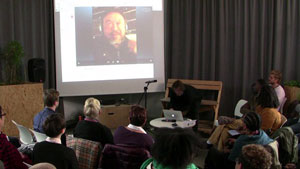
Olafur Eliasson & Ai Weiwei
Olafur Eliasson conducts a video interview with Ai Weiwei to introduce their collaboration, Moon, an online space where anyone can contribute a mark, a drawing, or an image to an integrated sphere. Through messages and non-verbal communication in a language unique to each person, the collective work becomes a testament to personal freedom, creativity, and activity.
Synthesis
Journeys and connections • Archival thinking • Retroactivity or proactivity? • Contemporary concept of the archive • Changing views • The objective vs. the subjective view of History • Ausklappen...
Journeys and connections • Archival thinking • Retroactivity or proactivity? • Contemporary concept of the archive • Changing views • The objective vs. the subjective view of History • The emergent fields of Structuralism and Post-Structuralism in relation to archives • ‘To archive’ • Producing realities from archives • Subjectivity and the reality machine • The Moon Project • Ai Weiwei’s current situation • Secret police surveillance • Activating the Moon Project via video conference • Ai Weiwei’s work in relation to the history of culture • Human consciousness • Digital media • The Chinese political situation • The Dalai Lama • Their partnership on the Moon Project • Description of the project • Moon as an archive in the making • The ethico-political issues of an open project • How much to censor? • The symbolic nature of the Moon • The consequence of self-expression
Short biographies
Olafur Eliasson, a Danish-Icelandic artist, founded the Institut für Raumexperimente, an educational research project, affiliated with the College of Fine Arts at the Berlin University of the Arts (UdK) and supported by the Senate for Education, Science and Research in Berlin and the Einstein Foundation Berlin. The fundamental trajectory of the Institut für Raumexperimente is Eliasson’s interest in testing models of learning and cultivating experimental formats.
Ai Weiwei is a Chinese contemporary artist involved in art, design, sculpture, architecture, curating, photography, writing, film, and social, political, and cultural criticism. His activities mainly focus on freedom of expression and ways to support human rights and social justice.
Olafur Eliasson führt ein Videointerview mit Ai Weiwei um in ihre Zusammenarbeit für Moon, einem Online-Raum, in dem jeder ein Zeichen, eine Zeichnung oder ein Bild auf einer digitalen Mondoberfläche einschreiben kann, einzuführen. Die kollektive Arbeit wird durch Nachrichten und nonverbale Kommunikation in einer für jeden Beitragenden individuellen Sprache zu einem Zeugnis für persönliche Freiheit, Kreativität und Aktivität.
Synthese
Reisen und Verbindungen • Archivisches Denken • Retroaktivität oder Proaktivität? • Zeitgenössisches Konzept des Archivs • Sich ändernde Ansichten • Objektive versus subjective Sicht auf Geschichte • Ausklappen...
Reisen und Verbindungen • Archivisches Denken • Retroaktivität oder Proaktivität? • Zeitgenössisches Konzept des Archivs • Sich ändernde Ansichten • Objektive versus subjective Sicht auf Geschichte • Das neue Gebiet von Strukturalismus und Post-Strukturalismus im Verhältnis zu Archiven • Archivieren • Schaffen von Realitäten aus Archiven • Subjektivität und die Realitätsmaschine • The Moon Project • Ai Weiweis aktuelle Situation • Überwachung durch Geheimpolizei • Aktivierung des Moon Project per Videokonferenz • Ai Weiweis Arbeit in Bezug zur Kulturgeschichte • Menschliches Bewusstsein • Digitale Medien • Die politische Situation in China • Der Dalai Lama • Ihre Zusammenarbeit beim Moon Project • Beschreibung des Projektes • Moon als entstehendes Archiv • Die ethnopolitischen Probleme eines offenen Projektes • Wieviel zensieren? • Die symbolische Natur des Mondes • Die Konsequenzen des persönlichen Ausdrucks
Kurzbiografien
Olafur Eliasson, dänisch-isländischer Künstler, gründete das Institut für Raumexperimente, ein Studien- und Forschungsprojekt, das Teil der Fakultät für Bildende Kunst an der Universität der Künste Berlin (UdK) ist. Eliassons Interesse, neue Lernmodelle zu testen und experimentelle Formate zu kultivieren, ist grundlegender Bestandteil des Institutsprogramms.
Ai Weiwei ist ein chinesischer zeitgenössischer Künstler, der sich mit Kunst, Design, Bildhauerei, Architektur, Kuration, Photografie, Schreiben, Film und sozialer, politischer sowie kultureller Kritik beschäftigt. Seine Aktivitäten beschäftigen sich hauptsächlich mit Meinungsfreiheit und der Unterstützung von Menschenrechten und sozialen Gerechtigkeit.
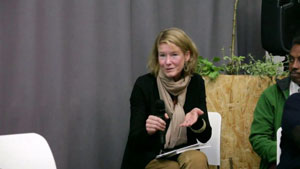
Beatrice von Bismarck
Beatrice von Bismarck speaks of the creation of the MA programme Cultures of the Curatorial and the involvement of the course participants in the curatorial project The Subjective Object. The project dealt with an archive of anthropological photography from the late 1920s of the Adivasi people of India and the political and socio-historical issues related to this archive. Several key questions are raised regarding colonialism, the anthropological gaze, the role of museums, the status of exhibits, the role of photography in relation to communal memory, and the ontological standing of the photograph itself.
Synthesis
Producing art and archives out of existing archives · The Subjective Object · The culture of a curatorial course · A project under the conditions of institutional limitations or perspectives · Ausklappen...
Producing art and archives out of existing archives · The Subjective Object · The culture of a curatorial course · A project under the conditions of institutional limitations or perspectives · How do things work within state institutions and how do we want to make them work in a different way? · Problematising the German photographic archive on the Adivasi of India in the Leipzig Museum of Ethnography · How can something so reproducible and unoriginal and not object-like be repatriated? · To bring that encounter in documented form back to Germany · The images helped create the Adivasi Academy in India · What has the photograph turned to? · What kind of item are we looking at? · Is this a document? · Is this in fact an object of the ancestors? · Is this a representation that equals the status of the ancestors? · The museum itself as an invention of the West now transplanted to India · The constantly shifting status of the image · How do you feed them back into a process of reading and rereading and even reconstructing a history through a constant rereading? · What can images actually do? · What do objects do? · How does meaning attach itself to images that gets shed away again through different contextualisation? · How can images become agents?
Short biography
Beatrice von Bismarck, professor of art history and visual culture at the Academy of Visual Arts Leipzig, is the co-founder and co-director of the project space Ausklappen...
Beatrice von Bismarck, professor of art history and visual culture at the Academy of Visual Arts Leipzig, is the co-founder and co-director of the project space Kunstraum der Leuphana Universität Lüneburg and of the project space /D/O/C/K at the Academy of Visual Arts Leipzig. She initiated and co-directs the MA programme Cultures of the Curatorial. Her current research areas focus on modes of cultural production connecting theory and practice, curatorial practice, and the effects of neo-liberalism and globalisation on the cultural field. Her publications include the seminal book Interarchive: Archival Practices and Sites in the Contemporary Art Field (2002), which was edited with Hans-Peter Feldmann, Hans Ulrich Obrist, Diethelm Stoller, and Ulf Wuggenig.
Beatrice von Bismarck spricht über die Entwicklung des MA Studienganges Kulturen des Kuratorischen und die Beteiligung der Studierenden am kuratorischen Projekt “The Subjective Object”. Das Projekt beschäftigt sich mit einem anthropologischen Fotoarchiv aus den späten 1920er Jahren, das die indischen Adivasi zeigt. Politische und soziohistorische Fragestellungen in Zusammenhang mit diesem Archiv werden untersucht. Kernfragen werden in Hinblick auf Kolonialismus, den anthropologischen Blick, die Rolle des Museums, den Status von Ausstellungen, die Rolle von Fotografie in Bezug zu geteilter Erinnerung sowie die ontologische Position des Fotos selbst gestellt.
Synthese
Produktion von Kunst und Archiven aus bestehenden Archiven · The Subjective Object · Kulturen des Kuratorischen Studiengang · Projekte unter den Bedingungen institutioneller Einschränkung oder Perspektiven · Ausklappen...
Produktion von Kunst und Archiven aus bestehenden Archiven· The Subjective Object · Die Kultur eines kuratorischen Studienganges · Projekte unter den Bedingungen institutioneller Einschränkung oder Perspektiven · Wie funktionieren Dinge in staatlichen Institutionen und wie wollen wir sie auf andere Weise funktionieren lassen? · Problematisierung des deutschen Fotoarchives über die indischen Adivasi im Leipziger Museum für Ethnografie · Wie kann etwas so reproduzierbares und nicht-objekthaftes an seinen Ursprung zurückgeführt werden? · Dieses Treffen in dokumentierter Form nach Deutschland zurückbringen · Die Bilder trugen dazu bei, die Adivasi Academy in Indien zu gründen · Wohin hat sich das fotografische Bild gewendet? · Was für ein Ding sehen wir? · Ist dies ein Dokument? · Ist das hier vielleicht sogar ein Objekt der Vorfahren? · Ist dies eine Darstellung, die die Stellung der Vorfahren wertgleich repräsentiert? · Das Museum als westliche Erfindung, nach Indien übertragen · Die sich andauern verändernde Stellung des Bildes · Wie lassen sie sich wieder zurückführen in einen Prozess des Lesens, Wiederlesens und sogar der Rekonstruktion von Geschichte durch beständiges Wiederlesen? · Was können Bilder tatsächlich bewirken? · Was tun Objekte? · Wie erhalten Bilder Bedeutung, die dann durch unterschiedliche Kontexte wieder verschwindet? · Wie können Bilder aktiv handeln?
Kurzbiografie
Beatrice von Bismarck, Professorin für Kunstgeschichte an der Hochschule für Grafik und Buchkunst Leipzig ist Mitbegründerin und Co-Direktorin des Projektraumes Kunstraum Ausklappen...
Beatrice von Bismarck, Professorin für Kunstgeschichte an der Hochschule für Grafik und Buchkunst Leipzig ist Mitbegründerin und Co-Direktorin des Projektraumes Kunstraum an der Leuphana Universität in Lüneburg sowie des Projektraumes D/O/C/K an der Hochschule für Grafik und Buchkunst in Leipzig. Sie begründete den MA Studiengang Kulturen des Kuratorischen und leitet diesen als Ko-Direktorin. Ihre aktuelle Forschung konzentriert sich auf Modi der Kulturproduktion und verbindet Theorie mit Praxis, kuratorischer Praxis sowie den Einflüssen des Neoliberalismus und der Globalisierung auf den Kulturbereich. Zu ihren Publikationen zählt u.a. das Buch Interarchive: Archival Practices and Sites in the Contemporary Art Field (2002), das zusammen mit Hans-Peter Feldmann, Hans Ulrich Obrist, Diethelm Stoller und Ulf Wuggenig herausgegeben wurde.
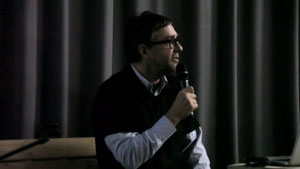
Jochen Becker
Jochen Becker speaks of the long-standing relationship between China and Africa, which he refers to as Chinafrica, challenging the preconceived notion that the trade links between China and Africa are a new phenomenon. As artistic examples for a contemporary notion of Chinafrica, he discusses the work of Sammy Baloji, Elke Marhöfer, Paolo Woods, and Michael MacGarry.
Synthesis
China • Africa • Chinafrica • The bilateral relationship between China and Africa • Arnold Meek • Haus der Kulturen der Welt • Global Prayers Project • Africans travelling to China to buy goods • Ausklappen...
China • Africa • Chinafrica • The bilateral relationship between China and Africa • Arnold Meek • Haus der Kulturen der Welt • Global Prayers Project • Africans travelling to China to buy goods • Chinese with African background • The China-Africa connection undermines the France-Africa one • Different African national approaches to China • African nation states, private companies, and individual entrepreneurs compete and collaborate when dealing with China • Chinafrica dates back to the 14th and 15th centuries • The Soviet Union and China compete for Africa in the 60s and 70s • China helps build African infrastructure • Building the railroads • The image of Africa in the Chinese media during the 70s • Cooperation, not help • Co-revolutionary aim • Renewed Chinese interest in Africa is economically led • The exploitation of the copper belt • Congolese artist Sammy Baloji • Decolonisation • Hong Kong • Artist Elke Marhöfer • The fast-paced change of Lagos, Nigeria, due to Chinese influence • Artist Paolo Woods • Fantasies of colonialism • Artist Michael MacGarry • Chocolate City
Short biography
Jochen Becker, author, lecturer, and curator based in Berlin and Stockholm. He is a founding member of metroZones – Center for Urban Affairs Ausklappen...
Jochen Becker, author, lecturer, and curator based in Berlin and Stockholm. He is a founding member of metroZones – Center for Urban Affairs and has edited several books, including BIGNES? (2001), Kabul/Teheran 1979ff (2006), and Urban Prayers (2011). He has (co)curated exhibitions such as The Urban Cultures of Global Prayers (2012/13, nGbK Berlin, Camera Austria, Graz) and Self Made Urbanism Rome (2013, nGbK Berlin; 2014, Rome). He was artistic director of the Global Prayers Project at Haus der Kulturen der Welt in Berlin. In 2014, he began teaching in the postgraduate Art & Architecture programme at the Royal Institute of Art, Stockholm.
Jochen Becker spricht über die seit langem bestehende Beziehung zwischen China und Afrika, die er als Chinafrika bezeichnet und damit Vorurteile wiederlegt, die die Handelsbeziehungen zwischen China und Afrika als ein neues Phänomen betrachten. Als künstlerische Beispiele für ein zeitgenössisches Verständnis von Chinafrika bespricht er Werke von Sammy Baloji, Elke Marhöfer, Paolo Woods und Michael MacGarry.
Synthese
China • Africa • Chinafrica • Die bilaterale Beziehung zwischen China und Afrika • Arnold Meek • Haus der Kulturen der Welt • Global Prayers Project • Afrikaner, die nach China reisen um Waren einzukaufen • Ausklappen...
China • Africa • Chinafrica • Die bilaterale Beziehung zwischen China und Afrika • Arnold Meek • Haus der Kulturen der Welt • Global Prayers Project • Afrikaner die nach China Reisen um Waren einzukaufen • Chinesen mit afrikanischen Wurzeln • Die China-Afrika Verbindung untergräbt die Frankreich-Afrika Verbindung • National unterschiedliche Zugänge zu China innerhalb Afrikas • Afrikanische Nationalstaaten, private Unternehmen und Unternehmer kollaborieren und stehen beim Handel mit China im Wettstreit • Chinafrica lässt sich bis zum 14. und 15. Jahrhundert zurückverfolgen • Wettstreit der Sowietunion und Chinas um Afrika in den 1960er und 1970er Jahren • China hilft beim Aufbau einer afrikanischen Infrastruktur • Bau der Eisenbahnlinien • Das Bild Afrikas in den chinesischen Medien während der 1970er Jahre • Kooperation, keine Hilfe • Ko-revolutionäres Ziel • Wiedererwachtes chinesisches Interesse an Afrika ist wirtschaftlich motiviert • Die Erforschung des Kupfergürtels • Der kongolesische Künstler Sammy Baloji • Dekolonalisierung • Hong Kong • Die Künstlerin Elke Marhöfer • Die schnelle Veränderung von Lagos, Nigeria, bedingt durch chinesischen Einfluss • Der Künstler Paolo Woods • Fantasien des Kolonialismus • Der Künstler Michael MacGarry • Chocolate City
Kurzbiografie
Jochen Becker, Autor, Lehrender und Kurator, der in Berlin und Stockholm lebt. Er ist Gründungsmitglied von metroZones – Center for Urban Affairs, Ausklappen...
Jochen Becker, Autor, Lehrender und Kurator, der in Berlin und Stockholm lebt. Er ist Gründungsmitglied von metroZones – Center for Urban Affairs, und Herausgeber zahlreicher Publikationen, einschließlich BIGNES? (2001), Kabul/Teheran 1979ff (2006) und Urban Prayers (2011). Er (ko)kuratierte Ausstellungen wie The Urban Cultures of Global Prayers (2012/2013, nGbK, Berlin, Camera Austria, Graz) und Self Made Urbanism Rome (2013nGbK Berlin; 2014, Rom). Er war künstlerischer Leiter des Global Prayers Project am Haus der Kulturen der Welt in Berlin. Im Jahr 2014 begann er im Rahmen eines postgraduierten Studienganges in Kunst und Architektur am Royal Institute of Art in Stockholm zu unterrichten.
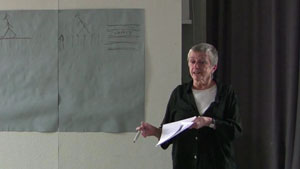
Doreen Massey: Space and Responsibility
Doreen Massey presents a lecture with running discussion, where she puts forward four propositions to be expanded upon and discussed with the audience. These are 1) space is full of time, 2) to be more outward-looking, 3) space is the dimension of multiplicity, and 4) the necessity to keep space open and alive. Within this framework several subjects are explored, such as the relation between space and time and the political implications of this relation; the relation between the local and the global; the need to change established worldviews; how to re-conceptualise space as a political dimension; and how to keep space open for new political possibilities.
Synthesis
A critique of neoliberalism · Making space social · Proposition 1 – space is full of time · We should not counterpose space and time · Space is temporalised · So why does that matter? · Ausklappen...
A critique of neoliberalism · Making space social · Proposition 1 – space is full of time · We should not counterpose space and time · Space is temporalised · So why does that matter? · The reason it matters is that it brings space alive · Space is not just a product of our actions · Spatial organisation has effects · It feeds back into the organisation of society · Space is a responsibility · We must deliberate about the spaces we make because they have effects · Implicitly we always think of space as a surface · The crossing of space to discover new cultures – a European view of the world · That’s not correct · If space is temporal then we walk across a multitude of stories · Space is a cut across a multitude of stories · That automatically complicates walking · The discovery of new cultures was a meeting of different trajectories · A lot of neoliberal critique of space is a critique of a point on a timeline · Generally a critique of the past · Museums follow this practice · It closes the past, encloses it · Patrick Keiller · Films that are walks · A recognition that stories continue · Space is not a surface it is a multiplicity of stories so far · Walking across space is to walk past several on going stories · The past is unfinished, it continues to pose questions for us today · Spatial Divisions of Labour · The interpretation of the past is a political activity · There is an active reconstruction of the past, an active forgetting · The reconceptualisation of space is a political activity · Science Bytes · Seeking a Gestalt shift · The narrative of progress is linear · Difference is organised in a historical sequence · These are the grand narratives · Once the grand narrative is specialised then it opens up to the possibility of political alternatives · Proposition 2 – to be more outward-looking · There is an awareness of the planet unparalleled in history · Contrasted by a total self-absorption · This must be challenged · The concept of identity and the relational aspect of identity construction initiated this · Every place is a hybrid construction · ‘A Global Sense of Place’ · Following relations around the world to see what our relationship is to these other parts of the world · The global shapes the local and the local shapes the global · We need a politics of arrivals and departures in terms of the relation between localities · A local politics of arrival and a global politics of departure · What is happening with migration? · A global ‘free’ labour market is emerging · We must become less self-absorbed in order to become critical of this emergent model · Personal reorientation · What are the processes for this to happen? · There are no fixed points · Anti-foundationalism · Anti-essentialism · How to get it across? · Proposition 3 – space is the dimension of multiplicity · Time is the dimension of the coexistence of trajectories of ‘nows’ · It is the dimension of our togetherness · Space imposes the most fundamental of political questions which is: how are we going to live together? · Space is the grounding dimension of the social · Radical contemporaneity – coevalness · A coexistence in time · In the grand narrative there is only one “now” · The multiplicity of views is the challenge that space sets for us · Chantal Mouffe · In order for there to be politics there must be opposition · Proposition 4 – the necessity to keep space open and alive · For there to be politics and democracy there must be no final point
Short biography
Doreen Massey, an Emeritus Professor at the Open University since 2009, remains active in a number of areas, most notably Ausklappen...
Doreen Massey, an Emeritus Professor at the Open University since 2009, remains active in a number of areas, most notably the AHRC project The future of landscape and the moving image with Patrick Keiller of the Royal College of Art and Professor Patrick Wright of Nottingham Trent University. Her ongoing book project Voices of Places, based on her Clarendon Lectures given at Oxford in 2008, is forthcoming from Oxford University Press. She is pursuing continuing interests in space and power through engagement with political change in Venezuela, where the concept of power-geometries has been taken up as part of the effort to extend grassroots and participatory democracy. She is a member of the Editorial Board for the journal Revista Pós at the School of Architecture and Urbanism of São Paulo, Brazil.
Doreen Massey präsentiert einen Vortrag, in dem sie vier Vorschläge macht, die mit dem Publikum diskutiert werden. Diese sind 1) Raum ist voll von Zeit, 2) Wir sollen uns mehr nach Außen orientieren, 3) Raum ist die Dimension von Vielfältigkeit, und 4) Wir müssen die Notwendigkeit anerkennen, Raum offen und lebendig zu erhalten. Innerhalb dieses Rahmens werden mehrere Themengebiete erforscht wie beispielsweise die Beziehung zwischen Raum und Zeit und die politischen Implikationen dieser Beziehung; die Beziehung zwischen dem Globalen und dem Lokalen; die Notwendigkeit etablierte Weltsichten zu ändern. Wie kann Raum als politische Dimension rekonzeptualisiert werden? Wie kann Raum für neue politische Möglichkeiten offen gehalten werden?
Synthese
Kritik an Neoliberalismus · Einen Ort sozial machen · Vorschlag 1 – Raum ist voll von Zeit · Wir sollten Raum und Zeit einander nicht gegenüberstellen · Raum ist verzeitlicht · Warum also ist das wichtig? · Ausklappen...
Kritik an Neoliberalismus · Einen Ort sozial machen · Vorschlag 1 – Raum ist voll von Zeit · Wir sollten Raum und Zeit einander nicht gegenüberstellen · Raum ist verzeitlicht · Warum also ist das wichtig? · Der Grund weswegen es wichtig ist, ist dass es Raum als etwas Lebendiges zurückbringt · Raum ist nicht nur ein Produkt unserer Handlungen · Räumliche Organisation hat Auswirkungen · Sie hat eine Rückwirkung auf die Organisation der Gesellschaft · Wir müssen über die Räume, die wir schaffen nachdenken · Denn sie haben alle Auswirkungen · Implizit denken wir Raum immer als Oberfläche · Das Durchqueren von Raum um neue Kulturen zu entdecken – und die europäische Weltsicht · Das stimmt nicht · Wenn Raum zeitlich ist dann bewegen wir uns über eine Vielzahl an Geschichten · Raum ist ein Querschnitt durch eine Vielzahl an Geschichten · So wird Laufen automatisch komplizierter · Die Entdeckung neuer Kulturen war ein Aufeinandertreffen unterschiedlicher Laufbahnen · Vieles der neoliberalen Kritik von Raum ist die Kritik eines Punktes auf einem Zeitstrahl · Grundsätzlich eine Kritik der Vergangenheit · Museen arbeiten nach dieser Praxis · Es schließt die Vergangenheit, umschließt es · Patrick Keiller · Filme, die Spaziergänge sind · Wahrnehmen dass Geschichten weitergehen · Raum ist keine Oberfläche sondern bis auf weiteres eine Vielzahl an Geschichten · Durch den Raum zu laufen bedeutet an mehreren fortlaufenden Geschichten vorbeizugehen · Die Vergangenheit ist unvollendet, sie gibt uns weiterhin Fragen für unser Heute auf · Spatial Divisions of Labour · Die Interpretation der Vergangenheit ist eine politische Tätigkeit · Es gibt eine aktive Rekonstruktion der Vergangenheit und ein aktives Vergessen · Die Rekonzeptualisierung von Raum ist eine politische Tätigkeit · Science Bytes · Eine Veränderung von Gestalt anstreben · Die Narration von Fortschritt ist linear · Differenz ist in historischen Sequenzen organisiert · Das sind die großen Erzählungen · Sobald die große Erzählung spezialisiert ist, öffnet sie sich für die Möglichkeit politischer Alternativen · Vorschlag 2 – Sich mehr nach Außen orientieren · Es gibt ein im Verlauf der Geschichte bisher so nie dagewesenes Bewusstsein für den Planeten · Im Kontrast dazu steht eine totale Selbstbezogenheit · Dies muss in Frage gestellt werden · Den Anfang dafür machte das Identitätskonzept und der Aspekt der Identitätskonstruktion · Jeder Ort ist ein hybrides Konstrukt · ‘A Global Sense of Place’ · Beziehungen weltweit verfolgen, um unsere Beziehung zu diesen anderen Teilen der Welt sehen zu können · Das Globale formt das Lokale und das Lokale formt das Globale · Wir brauchen eine Politik der Ankunft und der Abreise wenn es um die Beziehungen zwischen Orten geht · Eine lokale Politik der Ankunft und eine globale Politik der Abreise · Was passiert mit Migration? · Ein globaler ‘freier’ Arbeitsmarkt entwickelt sich · Wir müssen weniger selbstbezogen werden, um diesem entstehenden Modell kritisch gegenüber zu stehen · Persönliche Neuausrichtung · Welche Prozesse sind notwendig damit dies passiert? · Es gibt keine Fixpunkte · Anti-Fundamentalismus · Anti-Essentialismus · Aber wie bringt man das rüber? · Vorschlag 3 – Raum ist die Dimension von Vielfältigkeit · Zeit ist die Dimension der Koexistenz von Laufbahnen des pluralen ‘Jetzt’ · Es ist die Dimension unseres Zusammenseins · Raum setzt die grundlegendste aller politischen Fragen voraus, welche ist: Wie werden wir zusammenleben? · Raum ist die fundamentale Dimension des Sozialen · Radikale Gleichzeitigkeit – Zeitgleichheit · Eine Koexistenz in der Zeit · In den großen Erzählungen gibt es nur ein ‘Jetzt’ · Die Vielfalt von Ansichten ist eine Herausforderung, die der Raum an uns stellt · Chantal Mouffe · Damit es Politik geben kann muss es eine Opposition geben · Vorschlag 4 – Die Notwendigkeit, Raum offen und lebendig zu halten · Damit es Politik und Demokratie gibt darf es keinen Endpunkt geben
Kurzbiografie
Doreen Massey, seit 2009 emeritierte Professorin der Open University, ist weiterhin in vielen Bereichen aktiv. Ausklappen...
Doreen Massey,seit 2009 emeritierte Professorin der Open University, ist weiterhin in vielen Bereichen aktiv. Hiervon ist das AHRC Projekt The future of landscape and the moving image mit Patrick Keiller vom Royal College of Art und Professor Patrick Wright von der Nottingham Trent University das herausragendste. Ihr aktuelles Buchprojekt Voices of Places basiert auf den Claredon Lectures, die sie im Jahr 2008 in Oxford hielt und wird demnächst von Oxford University Press veröffentlicht. Sie verfolgt weiterhin ihre Interessen zu Themen von Raum und Macht durch ihr Engagement für politische Veränderungen in Venezuela. Dort ist ihr Konzept über Machtgeometrien aufgegriffen worden, um Grassroots- und partizipative Demokratiebewegung auszubauen. Sie ist Redaktionsmitglied der Zeitschrift Revista Pós an der School of Architecture and Urbanism in São Paulo, Brasilien.
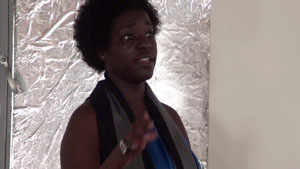
Elvira Dyangani Ose: Collective Art Practices
part I
part II
part III
Elvira Dyangani Ose presents a series of works by African artists as a basis for a discussion with a group of students from Addis Ababa and Berlin. Several questions and issues are raised in relation to curatorial practices such as how an artist’s biography influences the collection of his or her work; the building of public space; the role of art in society; ‘African-ness’; Jürgen Habermas’s concept of public space; the use of public space by artists; the breakdown between centre and periphery in the art world; the politics of labelling world art in order to make it collectible; and the Western artist as opposed to the non-Western artist.
Synthesis
Question of identity · Post-colonialism · Growing up in Spain and studying art history · How artists deal with public space · How artists use their own biography to deal with public space · Ausklappen...
Question of identity · Post-colonialism · Growing up in Spain and studying art history · How artists deal with public space · How artists use their own biography to deal with public space · What influences the collectability of art? · The influence of history and theory of architecture on Dyangani Ose’s curatorial career · Collective-ness is a central issue today · What is the role of the artist in society? · Do African artists present a notion of ‘African-ness’? · Researching African art · Dyangani Ose’s work with Tate Modern and her focus on African art · Can artists claim the public sphere as theirs? · Artist collectives around Africa · Cultural platforms that show what is happening in different African cities · Using borrowed spaces to show artists’ work · Using the public space to blur the boundaries between artist and viewer · Interdisciplinary approach to art production · Political awareness through art · First Festival of Black Art in Dakar 1966 · Initial cultural policy for African art · Raising the question of how to understand “African art” · Defining differences between how Africans see their own art in relation to how the West sees it · New internationalism · The breakdown between centre and periphery · A single mega show cannot fully represent what Africa is · Important to look at specific contexts · Who can judge “African-ness”?
Short biography
Elvira Dyangani Ose is a Lecturer in Visual Cultures at Goldsmiths, University of London, and curator of the eighth Göteborg International Biennial for Contemporary Art, GIBCA 2015. Ausklappen...
Elvira Dyangani Ose is a Lecturer in Visual Cultures at Goldsmiths, University of London, and curator of the eighth Göteborg International Biennial for Contemporary Art, GIBCA 2015. From 2011 to 2014, she served as Curator of International Art at Tate Modern. Prior to her work at Tate, she was curator from 2004 to 2006 at the Centro Atlántico de Arte Moderno (CAAM), Las Palmas la Gran Canaria, Spain, and from 2006 to 2008 at the Centro Andaluz de Arte Contemporáneo (CAAC), Seville. At the CAAM, she curated works by, among others, Nicholas Hlobo, Tracey Rose, Moshekwa Langa, Zanele Muholi, and Mikhael Sutbozky. She has curated the retrospective exhibition Carrie Mae Weems: Social Studies at CAAC (2010) and the interdisciplinary project Attempt to Exhaust an African Place at Centre d’Art Santa Mònica, Barcelona (2007–2008). She was also guest curator of the triennial SUD – Salon Urbain de Douala, Douala, Cameroon (2010), and the Artistic Director of the third Rencontres Picha: Lubumbashi Biennial, Democratic Republic of Congo (2013). Dyangani Ose has published and lectured on modern and contemporary African art and has contributed to art journals such as NKA and Atlántica.
Teil I
Teil II
Teil III
Elvira Dyangani Ose präsentiert eine Reihe von Arbeiten afrikanischer Künstler, die als Diskussionsgrundlage für die Gruppe der Studierenden der Alle School of Fine Arts and Design und des Instituts für Raumexperimente dienen. Es werden Fragen in Bezug auf kuratorische Praktiken gestellt, so etwa: Welchen Einfluss hat die Biographie eines Künstlers darauf, ob seine Werke gesammelt werden? Welchen Einfluss hat das Labeln von internationaler Kunst, um diese sammelbar zu machen? Desweiteren werden Fragen zum Entstehen öffentlichen Raums und der Rolle von Kunst in der Gesellschaft gestellt. Fragen, die ebenfalls diskutiert werden, lauten: Existiert Jürgen Habermas Konzept vom öffentlichen Raum? Wie nutzen Künstler öffentlichen Raum? Gibt es Afrikanizität? Gibt es Entkopplung von Zentrum und Peripherie in der Kunstwelt? Was ist ein westlicher, beziehungsweise nicht-westlicher Künstler?
Synthese
Identitätsfragen · Postkolonialismus · In Spanien aufwachsen, hat Kunstgeschichte studiert · Wie gehen Künstler mit öffentlichem Raum um? · Arten, auf die Künstler ihre eigenen Biographie in Interaktion mit öffentlichem Raum nutzen · Ausklappen...
Identitätsfragen · Postkolonialismus · In Spanien aufwachsen · Hat Kunstgeschichte studiert · Wie gehen Künstler mit öffentlichem Raum um? · Arten, auf die Künstler ihre eigenen Biographie in Interaktion mit öffentlichem Raum nutzen · Was beeinflusst die Sammelbarkeit von Kunst? · Geschichte und Architekturtheorie beeinflussen ihre kuratorische Laufbahn · Kollektivität ist heute ein zentrales Thema · Was ist die Rolle des Künstlers in der Gesellschaft? · Repräsentieren afrikanische Künstler eine Form von Afrikanizität? · Recherche zu afrikanischer Kunst · Beginnt bei Tate Modern zu afrikanischer Kunst zu arbeiten · Können Künstler öffentlichen Raum für sich beanspruchen? · Künstlerkollektive in Afrika · Kulturelle Plattformen, die zeigen was in afrikanischen Städten passiert · Geliehene Orte zur Ausstellung von Kunstwerken · Nutzung des öffentlichen Raums um die Grenzen zwischen Künstlern und Publikum zu verwischen · Interdisziplinärer Ansatz in Sachen Kunstproduktion · Politisches Bewusstsein durch Kunst · First Festival of Black Art in Dakar 1966 · Erste Kulturpolitik für afrikanische Kunst · Frage danach wie „afrikanische Kunst“ verstanden werden kann · Differenzen zwischen dem Verständnis von afrikanischer Kunst durch Afrikaner im Gegensatz zum Westen definieren · Neuer Internationalismus · Zusammenbruch der Trennung zwischen Zentrum und Peripherie · Eine einzige große Ausstellung kann nicht zeigen was afrikanische Kunst ist · Es ist wichtig spezifische Zusammenhänge zu betrachten · Wer legt fest was „afrikanisch“ bedeutet ?
Kurzbiografie
Elvira Dyangani Ose ist Lehrende für visuelle Kultur am Goldsmiths College der University of London und Kuratorin der achten Ausgabe der Göteborg International Biennial for Contemporary Art, GIBCA 2015. Ausklappen...
Elvira Dyangani Ose ist Lehrende für visuelle Kultur am Goldsmiths College der University of London und Kuratorin der achten Ausgabe der Göteborg International Biennial for Contemporary Art, GIBCA 2015. Sie war von 2011 bis 2014 Kuratorin für Internationale Kunst an der Tate Modern. Zuvor war sie Kuratorin des Centro Atlántico de Arte Moderno (2004 – 2006) und am Centro Andaluz de Arte Contemporáneo (2006 – 2008). Am CAAM kuratierte sie die wegweisende Ausstellung Olvida Quien Soy / Erase Me From Who I Am (2006) und zeigte hier unter anderem Werke von Nicholas Hlobo, Tracey Rose, Moshekwa Langa, Zanele Muholi und Mikhael Sutbozky. Sie kuratierte die retrospektive Ausstellung Carrie Mae Weems: Social Studies (2010) und das interdisziplinäre Projekt Attempt to Exhaust an African Place (2007–2008). Sie war außerdem Kuratorin von Arte Invisible (2009–2010), Gastkuratorin der Triennale SUD-Salon Urbain de Douala (2010) und künstlerische Leiterin der dritten Ausgabe von Rencontres Picha: Lubumbashi Biennial (2013), Demokratische Republik Kongo. Dyangani Ose publiziert zu moderner und zeitgenössischer afrikanischer Kunst, hält Vorträge und verfasst regelmäßig Beiträge für Kunstmagazine wie NKA und Atlántica.

Addis Art Practices Marathon
The Addis Art Practices Marathon takes place at the Alle School of Fine Art and Design, Addis Ababa University, in the context of the institute’s ten-week-long presence in Addis Ababa. Participating guests speak about their backgrounds and the directions in which their interests are leading them. Additionally, they present case studies that reflect their practices, approaches, and experiences in relation to the questions below. The initial short statements and examples facilitate multilayered discussions throughout the course of the marathon, focused on contemporary art practices in Addis Ababa.
Part I: Key questions
What is the position from which you practice and support art today, and what is the potential as well as the responsibility of art in 21st-century Addis Ababa?
Part II: Initial questions for the open discussion
What is the responsibility of art education?
What does it means to be an artist in Addis Ababa?
What are the options for young art practices in Addis Ababa today?
What are the visions?
What are the resources and assets in arts in Ethiopia (as well as in Africa and the global art market)?
Guest speakers: Seyoum Ayalew and Adam Michael, Ethiopian Visual Artist Association; Grima Bulti, National Museum of Ethiopia; Aida Muluneh, Addis Foto Fest; Eshetu Tiruneh, Enlightment Art Academy; Berhanu Ashagrie Deribew, Alle School of Fine Art and Design; Mihret Kebede, Netsa Art Village; Aklilu Temesgen, Five Art Studio; Meskerem Assegued, ZOMA Contemporary Art Center; moderated by Eric Ellingsen and Christina Werner, Institut für Raumexperimente
Der Addis Art Practices Marathon findet an der Alle School of Fine Art and Design, Addis Abeba University im Rahmen eines zehnwöchigen Austausches mit dem Institut für Raumexperimente statt. Teilnehmende Gäste sprechen hier über ihren Hintergrund und die Richtungen, in die ihre Interessen sie führen. Zusätzlich stellen sie Fallstudien vor, die relevant für Praktiken, Ansätze und Erfahrungen im Bezug zu untenstehenden Fragen sind. Ihre kurzen Statements und Beispiele ermöglichen eine vielschichtige Diskussion mit Fokus auf zeitgenössische Kunstpraktiken in Addis Abeba.
Teil I: Hauptfragen
Aus welcher Position heraus praktizierst und unterstützt Du heute Kunst? Welches Potential und welche Verantwortung hat Kunst im Addis Abeba des 21. Jahrhunderts?
Teil II: Ausgangsfrage für die offene Diskussion
Welche Verantwortung hat künstlerische Bildung?
Was bedeutet es, in Addis Abeba Künstler zu sein?
Welche Möglichkeiten gibt es heutzutage in Addis Abeba für junge Kunstschaffende?
Was sind die Visionen?
Was sind die Ressourcen und Vorteile für Kunst in Äthiopien (sowie in Afrika und auf dem globalen Markt)?
Gastteilnehmer: Seyoum Ayalew und Adam Michael, Ethiopian Visual Artist Association; Grima Bulti, Äthiopisches Nationalmuseum; Aida Muluneh, Addis Foto Fest; Eshetu Tiruneh, Enlightment Art Academy; Berhanu Ashagrie Deribew, Alle School of Fine Art and Design; Mihret Kebede, Netsa Art Village; Aklilu Temesgen, Five Art Studio; Meskerem Assegued, ZOMA Contemporary Art Center; moderiert von Eric Ellingsen und Christina Werner, Institut für Raumexperimente
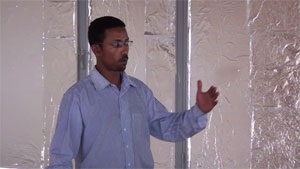
Abebaw Ayalew
part I
part II
Abebaw Ayalew delivers a lecture focused on traditional Ethiopian painting, spanning from the early period of Christianity to the present day. With the help of slides, he plots the evolution of iconographic themes over time. The presentation also highlights Ethiopia’s political and economic relationship with other countries, as illustrated by the influence that these relationships exert on Ethiopian painting, an influence that continues today.
Synthesis
Brief survey of Ethiopian traditional painting · Called traditional because techniques are passed down without change · Continuity through the generations · Ausklappen...
Brief survey of Ethiopian traditional painting · Called traditional because techniques are passed down without change · Continuity through the generations · Christian iconography · Visual models for early iconographic paintings came from other places · The Eusebian Canons help to establish early sources of influence from the 4th century onwards · Eusebius, a monk and bible scholar, charts the relationship between the four gospels · Patterns and frames in the paintings illustrate the relationship to the Eusebian Canons · The colours in traditional paintings are limited to six: black, white, green, yellow, red, and blue · Colours reflect the availability of pigments and form a symbolic language · Portrait depictions have only three poses: front, two thirds, and profile · The first two poses reserved for holy or saintly persons · Paintings marked by symbolism rather than mimesis · Iconography a source of theological arguments · Paintings lack three-dimensionality · Depth and illusion not used · Byzantine iconography a heavy influence · Travellers brought images that were then copied and adapted · The flow of influence was one-way only: Ethiopian paintings were sent to Jerusalem and the Vatican but only as examples, not as models · Three distinct periods in Ethiopian iconography: 15th, 16th, and 18th centuries · 16th century: Jesuits arrive with models of icons and Ethiopian painting focuses on narratives · 17th century: painting more decorative · 18th century marks significant changes · Ethiopia starts trading with other countries, introducing new colours for pigments and paints · Painting no longer reserved for the clergy; nobility has itself depicted, as well, with significant changes in the visual language · Political and economic changes in Ethiopia end the traditional patronage of Ethiopian paintings · Paintings were then produced only for foreign consumption · The technological innovations of the early 20th innovations brought significant changes to traditional painting · Today it is no longer taught in schools
Short biography
Abebaw Ayalew is an art historian teaching at the Addis Ababa University Alle School of Fine Arts and Design. Ausklappen...
Abebaw Ayalew is an art historian teaching at the Addis Ababa University Alle School of Fine Arts and Design. His research focuses on various aspects of Ethiopian art history, specifically on the history of Ethiopian painting in the 18th and 19th centuries. Recently, he has carried out extensive research on historical monuments in Addis Ababa, including one of the country’s most important, the martyrs’ monument at Yekatit 12 Square, Sidist Kilo.
Teil I
Teil II
Abebaw Ayalew hält einen Vortrag zu traditioneller äthiopischer Malerei, angefangen in der frühchristlichen Periode bis in die Gegenwart. Anhand von Dia-Projektionen zeigt er, wie sich ikonographische Themen durch die Zeit entwickelt haben. Die Präsentation hebt außerdem die politische und wirtschaftliche Beziehung Äthiopiens zu anderen Ländern heraus. Diese lässt sich besonders gut durch den Einfluss, den solche Beziehungen auf den Stil in äthiopischer Malerei bis heute haben nachvollziehen.
Synthese
Kurzer Überblick zu traditioneller äthiopischer Malerei · Verstanden als traditionell weil Techniken ohne Änderungen weitergegeben werden · Kontinuität durch die Generationen · Ausklappen...
Kurzer Überblick zu traditioneller äthiopischer Malerei · Verstanden als traditionell weil Techniken ohne Änderungen weitergegeben werden · Kontinuität durch die Generationen · Christliche Ikonographie · Visuelle Vorbilder für frühe Malerei kamen von anderswo · Die eusebischen Einteilungen sind ab dem 4. Jahrhundert frühe, einflussnehmende Quellen · Eusebius war ein Mönch und Bibelgelehrter · Er schuf eine Tabelle, die die Beziehung zwischen den vier Evangelien zeigte · Muster und Rahmen in den Gemälden verdeutlichen die Beziehung zu den eusebischen Einteilungen · Farbgebung in traditioneller Malerei ist auf sechs Farben beschränkt: Schwarz, Weiß, Grün, Gelb, Rot und Blau · Die Farbwahl gibt Aufschluss über die Verfügbarkeit von Pigmenten · Portraitabbildungen gibt es nur in drei Posen, frontal, zwei Drittel und Profil · Die ersten zwei: nur für Heilige oder Selige · Gemälde kommen ohne Mimesis aus · Äthiopische Gemälde sollen ausschließlich symbolisch sein · Mimesis konkretisiert ein Bild · Ikonographie wurde zur Quelle theologischer Auseinandersetzungen · Gemälde sollten nicht dreidimensional sein · Tiefe und Illusion sollen nicht verwendet werden · Byzantinische Ikonographie war ein starker Einfluss · Reisende brachten Bilder mit, die dann kopiert und imitiert wurden · Einflüsse bewegten sich nur in eine Richtung: Äthiopische Gemälde wurden nach Jerusalem und in den Vatikan gesendet, allerdings lediglich als Beispiele und nicht als Vorbilder · Drei deutlich abgrenzbare Perioden der äthiopischen Malerei im 15., 16. und 18. Jahrhundert · Ab dem 16. Jahrhundert konzentrierte sich die äthiopische Malerei auf Erzählungen · Ab dem 17. Jahrhundert wurde sie auch dekorativer · Das 18. Jahrhundert war mit deutlichen Verändernugen verbunden · Äthiopien beginnt mit anderen Ländern zu handeln · Veränderung der Farben durch neue Pigmente und fertige Malfarben · Malerei nicht länger ausschließlich für den Klerus; Adel begann sich malen zu lassen und dies veränderte die Bildsprache nachhaltig · Politische und wirtschaftliche Veränderungen in Äthiopien setzten der Dominanz traditioneller Malformen ein Ende · Gemälde wurden nur noch für landesfremde Kunden produziert · Ab dem frühen 20. Jahrhundert brachten technologische Innovationen starke Veränderungen für die traditionelle Malerei · Heute wird sie in Schulen nicht mehr gelehrt
Kurzbiografie
Abebaw Ayalew ist Kunsthistoriker und lehrt an der Alle School of Fine Arts and Design an der Universität in Addis Abeba. Ausklappen...
Abebaw Ayalew ist Kunsthistoriker und lehrt an der Alle School of Fine Arts and Design an der Universität in Addis Abeba. Seine Forschung konzentriert sich auf verschiedene Aspekte der äthiopischen Kunstgeschichte, besonders die Geschichte der äthiopischen Malerei zwischen dem 18. und 19. Jahrhundert. Er hat aktuell umfangreiche Forschungen zu historischen Denkmälern in Addis Abeba durchgeführt, unter anderem zu einem der wichtigsten nationalen Denkmäler, dem Martyr’s Monument, Sidist Kilo.
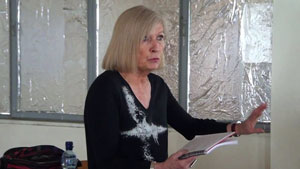
Chantal Mouffe: Agonistic Spaces
part I
part II
Chantal Mouffe presents a lecture on the basic tenets of her theory of politics and how artistic practices can intervene in political processes. She first lays the philosophical ground for her lecture: the critique of Essentialism and an introduction to a discursive approach, touching on the work of Freud, Lacan, Wittgenstein, and Gadamer. Secondly, she introduces and discusses her theory of an agonistic model of democracy. In this framework, she explores the role of artistic practice within the political process and its ability to intervene and help change established hegemonies through antagonistic positioning.
Synthesis
Where can artistic practice intervene? · Some philosophical concepts that are important to have as a basis · Sigmund Freud · The subject is a given, an idea questioned by critical essentialism · The concept of the divided subject between the conscious and the unconscious · Psychoanalysis can help to reach the unconscious but can never master it · Ludwig Wittgenstein – the subject cannot be the source of linguistic meaning · Ausklappen...
Where can artistic practice intervene? · Some philosophical concepts that are important to have as a basis · Sigmund Freud · The subject is a given, an idea questioned by critical essentialism · The concept of the divided subject between the conscious and the unconscious · Psychoanalysis can help to reach the unconscious but can never master it · Ludwig Wittgenstein – the subject cannot be the source of linguistic meaning · It is by participating in a variety of practices that the world is revealed to us · Hans-Georg Gadamer · It is by participating in languages that the world is disclosed to us · Pragmatism · There is no identity already there · Identity is constructed · Jacques Lacan · The subject is like an onion, constructed by layers of identification · The discursive approach – reality is always constructed through various discourses or signifying practices · Reality is only a product of discourse · Discourse is an articulation between linguistic things and material things · The object is always given to us by discursive articulation · The meaning of things is always constructed through a system of relations · Kicking a ball only becomes playing football when it is within a particular system of relations · Antonio Gramsci · The category of hegemony · A system of relations is always a system of power · There is no society without power · The structures can be changed but not eliminated · Every type of order is an hegemonic structure · Counter-hegemonic practices offer alternatives · There is always an alternative to the existing order · That is where artistic practices can act · Two main concepts – hegemony and antagonism · The aim of democracy is to establish a rational consensus · This is impossible, because if every order is hegemonic then there can be no reconciliation, only alternatives through antagonism · What are the consequences of this approach to democracy? · The task for political institutions is to aggregate interests and establish consensus · The pursuit of self-interest · Rational choice · John Rawls · Jürgen Habermas · To act as a citizen is to act towards the common good · Must differentiate between instrumental and communicative rationality · The role of passion in creating a collective form of identification · Affect is not irrational · We can accept a democratic model that encompasses antagonism · Democratic institutions within this model do not seek a rational consensus · Antagonism is a very specific form of conflict, one which can never reach a consensus · Antagonism in this democratic model can exist as a conflict between adversaries instead of enemies · They accept the legitimacy of their opponents · Not with the aim of destroying the other · The democratic process is accepted within the agonistic model · The opponent is treated as an equal · A process of persuasion to win over the opponent · There are competing views of the common good · Different agonistic spaces allow for different types of individualities to exist · The hegemonic model is particularly good to understand the relation between art and politics · Gramsci posited that hegemonies are created through civil society · Through a multiplicity of practices · The importance of culture in the creation and reproduction of the common sense · Our subjectivity is dependent on the types of practices in which we participate · Art and politics not separate from each other · They either contribute to the existent hegemony or they critique it · How can artistic practices have a critical position within traditional institutions today?
Short biography
Chantal Mouffe, political theorist educated at the universities of Louvain, Paris, and Essex, is professor of political theory at the University of Westminster. Ausklappen...
Chantal Mouffe, political theorist educated at the universities of Louvain, Paris, and Essex, is professor of political theory at the University of Westminster. She has taught at many universities in Europe, North America, and Latin America and has held research positions at Harvard, Cornell, the University of California, the Institute for Advanced Study in Princeton, and the Centre National de la Recherche Scientifique in Paris. Between 1989 and 1995, she was Directrice de Programme at the College International de Philosophie in Paris. Professor Mouffe is module leader of the CSD MA modules The State, Politics and Violence and Current Issues in Democratic Theory at the University of Westminster.
Teil I
Teil II
Chantal Mouffe hält einen Vortrag über die Grundlagen ihrer politischen Theorie und darüber wie künstlerische Praktiken in politische Prozesse eingreifen können. Zuerst legt sie die philosophische Grundlage für ihren Vortrag: Eine Kritik des Essentialismus und eine Einführung in die diskursive Theorie mit Erwähnung der Werke von Freud, Lacan, Wittgenstein und Gadamer. Danach führt sie in ihre Theorie eines agonistischen Demokratiemodells ein und diskutiert diese. Sie hinterfragt die Rolle künstlerischer Praxis innerhalb von politischen Prozessen und deren Fähigkeit einzugreifen und zur Veränderung von etablierten Herrschaftssystemen durch antagonistische Positionierung beizutragen.
Synthese
Wo kann künstlerische Praxis eingreifen? · Einige philosophische Konzepte die als Basis wichtig sind · Sigmund Freud · Dass das Subjekt gegeben ist wird vom kritischen Essentialismus in Frage gestellt · Konzept des geteilten Subjektes zwischen Bewusstsein und Unbewusstsein · Psychoanalyse kann helfen das Unbewusste zu erreichen, es aber nie beherrschen · Ludwig Wittgenstein – Das Subjekt kann keine Quelle linguistischer Bedeutung sein · Ausklappen...
Wo kann künstlerische Praxis eingreifen? · Einige philosophische Konzepte die als Basis wichtig sind · Sigmund Freud · Dass das Subjekt gegeben ist wird vom kritischen Essentialismus in Frage gestellt · Konzept des geteilten Subjektes zwischen Bewusstsein und Unbewusstsein · Psychoanalyse kann helfen das Unbewusste zu erreichen, es aber nie beherrschen · Ludwig Wittgenstein – Das Subjekt kann keine Quelle linguistischer Bedeutung sein · Die Welt erschließt sich uns durch die Teilnahme an einer Vielzahl von Praktiken · Hans-Georg Gadamer · Durch Sprache eröffnet sich uns die Welt · Pragmatismus · Es gibt keine Identität von vornherein · Identität ist konstruiert · Jacques Lacan · Das Subjekt gleicht einer Zwiebel · Das Subjekt setzt sich aus Identifikationslagen zusammen · Der diskursive Ansatz – Realität wird durch verschiedene Diskurse oder bedeutungssetzende Praktiken geschaffen · Realität ist lediglich ein Produkt von Diskursen · Diskurs ist eine Artikulation zwischen linguistischen Dingen und materiellen Dingen · Das Objekt erhalten wir immer durch diskursive Artikulation · Die Bedeutung von Dingen wird immer durch ein Beziehungssystem geschaffen · Einen Ball zu treten wird erst dann zum Fußball spielen wenn es Teil eines besonderen Beziehungssystems ist · Chantal Mouffes Ansatz · Antonio Gramsci · Hegemonie als Kategorie · Soziale Beziehungen werden immer durch Artikulation, durch Beziehungen geschaffen · Dieses Beziehungssystem ist immer ein Machtsystem · Es gibt keine Gesellschaft ohne Macht · Strukturen können geändert werden, aber nicht ausgelöscht · Jede Art von Ordnung ist eine hegemonische Ordnung · Gegenhegemonische Praktiken bieten eine Alternative · Es gibt immer eine Alternative zur bestehenden Ordnung · Dort können künstlerische Praktiken agieren · Zwei Hauptkonzepte – Hegemonie und Antagonismus · Ziel der Demokratie ist die Etablierung eines rationale Konsens · Das ist unmöglich denn wenn jede Ordnung eine Hegemonie ist kann es keine Übereinstimmung geben, nur Alternativen durch Antagonismus · Was sind die Konsequenzen aus diesem Demokratieverständnis? · Die Aufgabe für politische Institutionen ist es Interessen anzusammeln und einen Konsens zu etablieren · Das Verfolgen eines Eigennutzes · Rationale Entscheidung · John Rawls · Jürgen Habermas · Als Bürger zu handeln bedeutet für das Gemeinwohl zu handeln · Es muss zwischen rein funktionaler und kommunikativer Rationalität unterschieden werden · Die Rolle von Leidenschaft bei der Erschaffung einer kollektiven Identifikationsform · Affektive Dimension · Affekt ist nicht irrational · Wir können ein demokratisches Modell das Antagonismen einschließt akzeptieren · Demokratische Institutionen innerhalb dieses Modells suchen nicht nach einem rationalen Konsens · Die Rolle von demokratischen Institutionen ist demnach sich zu etablieren um so Antagonismen zulassen zu können ohne dabei die demokratische Ordnung zu zerstören · Antagonismus ist eine sehr spezifische Form des Konflikts, die nie einen Konsens erreichen kann · In diesem demokratischen Modell kann Antagonismus als Konflikt zwischen Gegenspielern statt Feinden bestehen · Eine antagonistische Beziehung ist die Art von Konflikt die zwischen Gegenspielern besteht · Sie akzeptieren die Legetimität ihres Gegenüber · Ohne das Ziel den anderen zu zerstören · Der demokratische Prozess wird im agonistischen Modell akzeptiert · Im liberalen Modell ist der Gegenspieler ein Konkurrent · Der Gegenüber wird als gleichwertig behandelt · Ein Überzeugungsprozess um über den Gegenspieler zu siegen · Es gibt Ansichten über das Allgemeinwohl, die miteinander im Wettstreit stehen · Unterschiedliche antagonistische Räume ermöglichen die Existenz unterschiedlicher Arten von Individualitäten · Das hegemonistische Modell ist besonders gut um die Beziehung zwischen Kunst und Politik zu verstehen · Gramsci postulierte, dass Hegemonien durch die Zivilgesellschaft geschaffen werden · Durch eine Vielzahl an Praktiken · Die Wichtigkeit von Kultur für die Schaffung und Reproduktion gesunden Menschenverstandes · Unsere Subjektivität hängt von den Praktiken an denen wir teilhaben ab · Kunst und Politik sind nicht voneinander getrennt · Sie tragen entweder zur bestehenden Hegemonie bei oder kritisieren sie · Wie kann künstlerische Praxis innerhalb traditioneller Institutionen heute eine kritische Position haben?
Kurzbiografie
Chantal Mouffe, Politikwissenschaftlerin mit Ausbildung an den Universitäten Louvain, Paris und Essex ist Professorin für politische Theorie an der University of Westminster. Ausklappen...
Chantal Mouffe, Politikwissenschaftlerin mit Ausbildung an den Universitäten Louvain, Paris und Essex. Sie ist Professorin für politische Theorie und Modulleiterin des CSD MA Moduls ‘The State, Politics and Violence and Current Issues in Democracy Theory’ an der University of Westminster. Sie lehrte an zahlreichen Universitäten in Europa, Nordamerika und Lateinamerika und hatte Forschungspositionen in Harvard, Cornell, der University of California, dem Institute for Advanced Studies in Princeton und am Centre National de la Recherche Scientifique in Paris inne. Zwischen 1989 und 1995 war sie Programmdirektorin des College International de Philosophie in Paris.
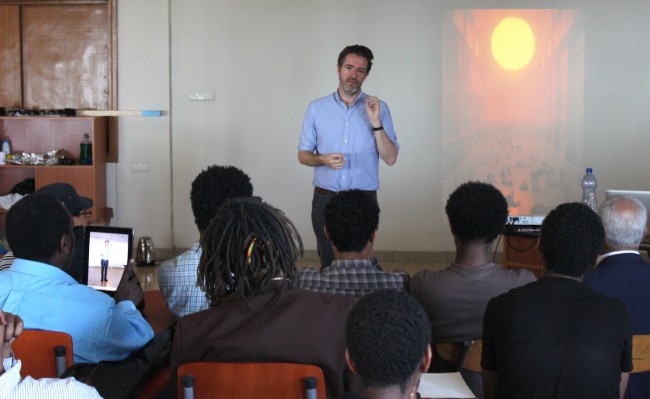
Olafur Eliasson: First Lecture
part I
part II
part III
Olafur Eliasson discusses the potential of art education, the importance of connectivity and engagement for art, and art’s responsibility to social involvement. This is the first of four lectures given by the artist in Addis Ababa in the context of an education collaboration between the Institut für Raumexperimente and the Alle School of Fine Arts and Design.
Synthesis
Reconsidering what a school has the potential to be • The idea of a journey, a trajectory, a progression, and their relation to an art school • Ausklappen...
Founder Director of the Institut für Raumexperimente in Berlin • Reconsidering what a school has the potential to be • The idea of a journey, a trajectory, a progression, and their relation to an art school • The need to focus on what is done without becoming obsessed with explanations • Traditional ‘stages of art production’ and how the institute has attempted to circumvent them • ProCoKnow Parliament and artwork production, communication, and knowledge • Artwork is relative to its engagement with the world • Artwork begins with the first feeling • The importance of having the school in Studio Olafur Eliasson and travelling with the school • Connectivity and art • Embodied and felt knowledge • The weather project • The value of collective experience • The ability to see oneself in a context is related to our ability to see oneself from the outside • Models and the relativity of reality • Model room • Your rainbow panorama • Body-artwork and body-environment relationship • Physical knowledge versus mediated knowledge • Erosion • Interventions and changing urban spaces • Artists’ responsibility for involvement and engagement • Movement and surroundings • Demystifying art for politics • Engaging critically with the art market • Double sunset and doing the impossible • Studio-school-museum interaction • Tickling experiment • Institut für Raumexperimente: vibration, connectivity, intersubjectivity • Little Sun and global shared needs
Short biography
Olafur Eliasson, Danish-Icelandic artist, founded the Institut für Raumexperimente, an educational research project, Ausklappen...
Olafur Eliasson, Danish-Icelandic artist, founded the Institut für Raumexperimente, an educational research project, affiliated with the College of Fine Arts at the Berlin University of the Arts (UdK). The fundamental trajectory of the Institut für Raumexperimente is Eliasson’s interest in testing models of learning and cultivating experimental formats.
Teil I
Teil II
Teil III
Olafur Eliasson spricht über das Potential künstlerischer Bildung, die Wichtigkeit von Verbundenheit und Engagement für Kunst sowie die Veranwortung der Kunst, sich sozial einzubringen. Der Vortrag ist der erste von insgesamt vier Vorträgen, die der Künstler im Rahmen einer Zusammenarbeit des Institutes für Raumexperimente mit der Alle School of Fine Arts and Design in Addis Abeba hielt.
Synthese
Überdenken, welches Potential in einer Schule steckt; was sie sein kann • Die Vorstellung einer Reise, einer Kurve, einer Entwicklung und deren Beziehung zur Kunsthochschule • Ausklappen...
Gründer und Leiter des Institut für Raumexperimente in Berlin • Überdenken, welches Potential in einer Schule steckt; was sie sein kann • Die Vorstellung einer Reise, einer Kurve, einer Entwicklung und deren Beziehung zur Kunsthochschule • Die Notwendigkeit, sich auf das zu konzentrieren was getan wird ohne besessen von Erklärungen zu werden • Traditionelle Bühnen der Kunstproduktion und wie das Institut versucht hat, diese zu umgehen • ProCoKnow Parliament und Kunstproduktion, Kommunikation und Wissen • Das Kunstwerk steht in Relation zu seinem Engagement in der Welt • Das Kunstwerk beginnt mit einem ersten Gefühl • Die Wichtigkeit, die Schule im Studio Olafur Eliasson zu haben und mit ihr reisen zu können • Vernetzbarkeit und Kunst • Verkörpertes und empfundenes Wissen • The weather project • Der Wert einer kollektiven Erfahrung • Die Fähigkeit, uns in einem Kontext zu sehen ist abhängig von unserer Fähigkeit, uns von außen zu betrachten • Modelle und die Relativität der Realität • Model room • Your rainbow panorama • Körper-Kunstwerk und Körper-Umgebung Beziehungen • Physisches Wissen versus vermitteltes Wissen • Erosion • Erfindungen und sich verändernde urbane Räume • Die Verantwortung von Künstlern für Engagement und Einmischung • Bewegung und Umgebung • Kunst für die Politik entmystifizieren • Kritische Auseinandersetzung mit dem Kunstmarkt • Your new bike • Double sunset und das Unmögliche tun • Interaktionen zwischen Studio, Schule und Museum • Kitzelexperiment • Institut für Raumexperimente: Vibration, Konnektivität, Intersubjektivität • Little Sun und global geteilte Bedürfnisse
Kurzbiografie
Olafur Eliasson, dänisch-isländischer Künstler, gründete das Institut für Raumexperimente, ein Studien- und Forschungsprojekt, Ausklappen...
Olafur Eliasson, dänisch-isländischer Künstler, gründete das Institut für Raumexperimente, ein Studien- und Forschungsprojekt, das Teil der Fakultät für Bildende Kunst an der Universität der Künste Berlin (UdK) ist. Eliassons Interesse, neue Lernmodelle zu testen und experimentelle Formate zu kultivieren, ist grundlegender Bestandteil des Institutsprogramms.
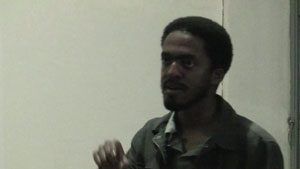
Brook Teklehaimanot: Addis and its Urbanism
part I
part II
part III
Brook Teklehaimanot delivers a detailed technical presentation on the urban development of Addis Ababa from its beginnings in the 19th century up to the present day. After a series of maps that detail the growth patterns of the city, he then moves to a number of photographs of modern-day Addis Ababa that examine different social and urban issues. The discussion also focuses on the relationship between neoliberal capitalism and contemporary city growth.
Synthesis
Addis Ababa and urbanism • Demographics and history of the city • Historical influences on the city’s development • Ethnic versus geographic boundaries • Ausklappen...
Addis Ababa and urbanism • Demographics and history of the city • Historical influences on the city’s development • Ethnic versus geographic boundaries • Roads and transportation infrastructure: organic • Zoning and functional division of the city • Population density • Living conditions across Addis • Mixed forms of transportation in the city with very dense transit corridors • Idiosyncrasies affecting urban development: Ethiopian shoppers
Short biographyBrook Teklehaimanot, a professor in the chair of Architecture and Design at Addis Ababa University, is director of the EiABC protoLAB, a centre with interests in design and fabrication techniques and on the urban development of Addis Ababa.
Teil I
Teil II
Teil III
Brook Teklehaimanot hält einen technisch detaillierten Vortrag zur Stadtentwicklung Addis Abebas, angefangen im 19. Jahrhundert bis in die Gegenwart. Nach einem Einstieg mit einer Reihe von Karten die die Wachstumsmuster der Stadt zeigen, geht er zu einer Serie Fotografien über, die Addis Abeba heute zeigen und verschiedene soziale und urbane Gegebenheiten untersuchen. Die Diskussion bezieht sich außerdem auf die Beziehung zwischen neoliberalem Kapitalismus und zeitgenössischem Stadtwachtum.
Synthese
Addis Abeba und Urbanismus • Demographie und Geschichte der Stadt • Geschichtliche Einflüsse auf die Stadtentwicklung • Ausklappen...
Addis Abeba und Urbanismus • Demographie und Geschichte der Stadt • Geschichtliche Einflüsse auf die Stadtentwicklung • Ethnische vs. geographische Grenzen • Straßen- und Beförderungsinfrastruktur: organisch • Aufteilung und funktionale Einteilung der Stadt • Bevölkerungsdichte • Lebensbedingungen in allen Teilen von Addis • Gemischte Art der Beförderung in der Stadt mit sehr dichten Routen • Empfindlichkeiten beeinflussen die Entwicklung urbanen Raums: Äthiopier sind nicht gewohnt, Läden in oberen Stockwerken zu suchen • Informelle wirtschaftliche Aktivitäten: Märkte im Freien • Gebäude dienen oft nur zu Werbezwecken und als Lagerräume während Handel fast ausschließlich draußen stattfindet • Die Käuflichkeit von allem in Addis • Verschwommene Grenzen zwischen ‘Innen’ und ‘Außen’ auf dem Markt • Fahrzeuge dienen als temporäre Lagerräume • ‘Bettenmakler’ – Betten für eine Nacht an müde Reisende vermitteln • Denkmäler und Ereignisse in Addis • Beispiele für Gebäude die nicht mit Passanten interagieren oder in Kontakt treten • Parks und grüner urbaner Raum • Kirche in Addis von einem Park mit Bäumen umgeben • Vielfalt und Diversität des Wohnens in der Stadt • Wohnprojekte • Wohnbauprojekte für die nahe Zukunft • Für die Stadt typische Gebäudearten • Einfluss durch westliche Architektur in den 1960er Jahren • Gut sichtbare Fassaden beliebt als Werbeflächen • Häuser für Reiche und Privilegierte • Typische Baumaterialien in urbanen, vorstädtlichen und ländlichen Gegenden • Baugerüste aus natürlichen Materialien • Informelle Beförderungsmittel, einschließlich Tiere • Zeitgenössische urbane Struktur in Addis
KurzbiografieBrook Teklehaimanot, Professor des Rates für Architektur und Design an der Addis Abeba University, ist Leiter des EiABC protoLAB, einem Zentrum mit Fokus auf Design, Produktionstechniken und Stadtentwicklung in Addis Abeba.
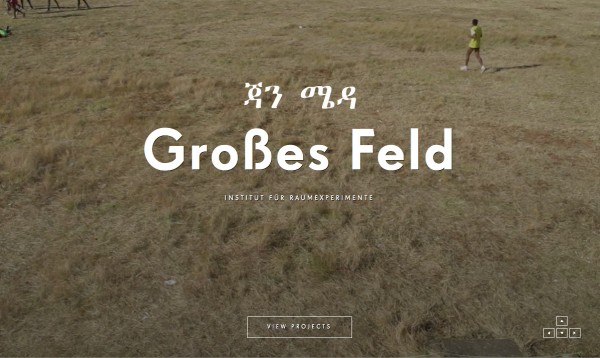
Jan Meda – Großes Feld
The Institut für Raumexperimente hosts a three-day art festival at Jan Meda, the former horse race track in Addis Ababa. The exhibition includes works by artists from Addis Ababa and Berlin. By facilitating the collaborative engagement of a unique group of artists and cultural producers, the programme creates an atmosphere of experimentation, friction, and radical movement that challenges the norms by which we create art, live together, and, thus, produce reality. Works include pavilions installed in the field, video, painting, sculpture and photography, installations, performances, workshops for children, a light sound workshop, cooking experiments, a lecture and film program, and a poetry jazz event.
Contributions by: AEAEAEAE, Malte Bartsch, Julius von Bismarck, Rune Bosse & Addis Ababa University Football Club, Merlin Carter, Julian Charrière, Leon Eixenberger, Leon Eixenberger, Eric Ellingsen, Tomas Espinosa, Henok Getachew, Tamrat Gezahegne, Andreas Greiner, Markus Hoffmann, Rike Horb, Clara Jo, Hans-Henning Korb, Mihret Kebede, Felix Kiessling, Fabian Knecht, Norgard Kröger, Robert Lippok, Felix Meyer, Simen Museus, Molly Nesbit, Lynn Peemoeller, Vinzenz Reinecke, Nina Schuiki, Robel Temesgen, Alkistis Thomidou, Raul Walch, Jonas Wendelin, Christina Werner, Euan Williams, Helen Zeru
View exhibition website.
Program:
13 December: Opening DayPerformances and walks by Eric Ellingsen, Simen Museus & Hans-Henning Korb, Henok Getachew, Rune Bosse & Robel Temesgen, Julian Charrière.
14 December: Film ScreeningVideo works by artists from Addis Abeba and Berlin: Eric Ellingsen, Fabian Knecht, Merlin Carter, Felix Meyer, Robel Temesgen, Raul Walch, and Jonas Wendelin
14 December: Conversation with Molly NesbitLecture at the exhibition
Click to view the video documentation of Molly Nesbit’s lecture Doubts and Habits of Actions in Time.
15 December: Ishe get ‘um, OK PoetryPoetry readings and performances by Eric Ellingsen, Mihret Kebede, Misrak Terefe, Abebaw Melaku, Demissew Mersha, Vinzenz Reinecke, Tadele Tewodros, and Addis Taem Band
Click to view the video documentation of the poetry performances.
Das Institut für Raumexperimente richtet ein dreitägiges Kunstfestival auf der früheren Pferderennbahn, Jan Meda, in Addis Abeba aus. Die Ausstellung zeigt Werke von Künstlern aus Addis Abeba und Berlin. So wird eine besondere Begegnung und Zusammenarbeit einer Gruppe von Künstlern und Kulturschaffenden ermöglicht. Hierdurch schafft das Festival eine experimentelle und spannungsgeladene Atmosphäre mit Offenheit für radikale Schritte. Normen nach denen wir Kunst machen, zusammen leben und Realität produzieren werden so in Frage gestellt. Die Arbeiten umfassen unter anderem Pavillons auf der Rennbahn, Video, Malerei, Skulptur und Fotografie, Installationen, Performances, Workshops für Kinder, einen Workshop mit Licht und Resonanz, Kochexperimente, ein Vorlesungs- und Filmprogramm sowie ein Jazz-Poetry Event.
Mit Beiträgen von: AEAEAEAE, Malte Bartsch, Julius von Bismarck, Rune Bosse & Addis Ababa University Football Club, Merlin Carter, Julian Charrière, Leon Eixenberger, Leon Eixenberger, Eric Ellingsen, Tomas Espinosa, Henok Getachew, Tamrat Gezahegne, Andreas Greiner, Markus Hoffmann, Rike Horb, Clara Jo, Hans-Henning Korb, Mihret Kebede, Felix Kiessling, Fabian Knecht, Norgard Kröger, Robert Lippok, Felix Meyer, Simen Museus, Molly Nesbit, Lynn Peemoeller, Vinzenz Reinecke, Nina Schuiki, Robel Temesgen, Alkistis Thomidou, Raul Walch, Jonas Wendelin, Christina Werner, Euan Williams, Helen Zeru
Website der Ausstellung besuchen.
Programm:
13. Dezember: EröffnungPerformances und Walks von Eric Ellingsen, Simen Museus & Hans-Henning Korb, Henok Getachew, Rune Bosse & Robel Temesgen, Julian Charrière.
14. Dezember: FilmabendVideos von Künstlern aus Addis Abeba und Berlin: Eric Ellingsen, Fabian Knecht, Merlin Carter, Felix Meyer, Robel Temesgen, Raul Walch und Jonas Wendelin
14. Dezember: Molly Nesbit: Doubts and Habits of Actions in TimeVortrag in der Ausstellung
Hier zur Videodokumentation des Vortrags von Molly Nesbit.
15 December: Ishe get ‘um, OK PoetryLesungen und Performances von Eric Ellingsen, Mihret Kebede, Misrak Terefe, Abebaw Melaku, Demissew Mersha, Vinzenz Reinecke, Tadele Tewodros und der Addis Taem Band
Die Videodokumentation der Performances anschauen.